This content originally appeared on The Intercept and was authored by The Intercept.
This post was originally published on Radio Free.
This content originally appeared on The Intercept and was authored by The Intercept.
This post was originally published on Radio Free.
By Patrick Decloitre, RNZ Pacific correspondent French Pacific desk
New Caledonia’s pro-and-anti-independence parties have committed to an “historic” deal over the future political status of the French Pacific territory, which is set to become — for the first time — a “state” within the French realm.
The 13-page agreement yesterday, officially entitled “Agreement Project of the Future of New Caledonia”, is the result of a solid 10 days of difficult negotiations between both pro and anti-independence parties.
They have stayed under closed doors at a hotel in the small city of Bougival, in the outskirts of Paris.

The talks were convened by French President Emmanuel Macron after an earlier series of talks held between February and May 2025 failed to yield an agreement.
After opening the talks on July 2, Macron handed over them to his Minister for Overseas, Manuel Valls, to oversee. Valls managed to bring together all parties around the same table earlier this year.
In his opening speech earlier this month, Macron insisted on the need to restore New Caledonia’s economy, which was brought to its knees following destructive and deadly riots that erupted in May 2024.
He said France was ready to study any solution, including an “associated state” for New Caledonia.
During the following days, all political players exchanged views under the seal of strict confidentiality.
While the pro-independence movement, and its Kanak and Socialist National Liberation Front (FLNKS), remained adamant they would settle for no less than “full sovereignty”, the pro-France parties were mostly arguing that three referendums — held between 2018 and 2021 — had already concluded that most New Caledonians wanted New Caledonia to remain part of France.
Those results, they said, dictated that the democratic result of the three consultations be respected.

With this confrontational context, which resulted in an increasingly radicalised background in New Caledonia, that eventually led to the 2024 riots, the Bougival summit was dubbed the “last chance summit”.
In the early hours of Saturday, just before 7 am (Paris time, 5 pm NZ time), after a sleepless night, the secrecy surrounding the Bougival talks finally ended with an announcement from Valls.
He wrote in a release that all partners taking part in the talks had signed and “committed to present and defend the agreement’s text on New Caledonia’s future.”
Valls said this was a “major commitment resulting from a long work of negotiations during which New Caledonia’s partners made the choice of courage and responsibility”.
The released document, signed by almost 20 politicians, details what the deal would imply for New Caledonia’s future.
In its preamble, the fresh deal underlines that New Caledonia was “once again betting on trust, dialogue and peace”, through “a new political organisation, a more widely shared sovereignty and an economic and social refoundation” for a “reinvented common destiny.”
New Caledonia’s population will be called to approve the agreement in February 2026.
If approved, the text would be the centrepiece of a “special organic law” voted by the local Congress.
It would later have to be endorsed by the French Parliament and enshrined in an article of the French Constitution.
What does the agreement contain?
One of the most notable developments in terms of future status for New Caledonia is the notion of a “State of New Caledonia”, under a regime that would maintain it as part of France, but with a dual citizenship — France/New Caledonia.
Another formulation used for the change of status is the often-used “sui generis”, which in legal Latin, describes a unique evolution, comparable to no other.
This would be formalised through a fundamental law to be endorsed by New Caledonia’s Congress by a required majority of three-fifths.
The number of MPs in the Congress would be 56.
The text also envisages a gradual transfer of key powers currently held by France (such as international relations), but would not include portfolios such as defence, currency or justice.
In diplomacy, New Caledonia would be empowered to conduct its own affairs, but “in respect of France’s international commitments and vital interests”.
On defence matters, even though this would remain under France’s powers, it is envisaged that New Caledonia would be “strongly” associated, consulted and kept informed, regarding strategy, goals and actions led by France in the Pacific region.
On police and public order matters, New Caledonia would be entitled to create its own provincial and traditional security forces, in addition to national French law enforcement agencies.
New Caledonia’s sensitive electoral roll
The sensitive issue of New Caledonia’s electoral roll and conditions of eligibility to vote at local elections (including for the three Provincial Assemblies) is also mentioned in the agreement.
It was this very issue that was perceived as the main trigger for the May 2024 riots, the pro-independence movement feared at the time that changing the conditions to vote would gradually place the indigenous Kanak community in a position of minority.
It is now agreed that the electoral roll would be partly opened to those people of New Caledonia who were born after 1998.
The roll was frozen in 2007 and restricted to people born before 1998, which is the date the previous major autonomy agreement of Nouméa was signed.
Under the new proposed conditions to access New Caledonia’s “citizenship”, those entitled would include people who already can vote at local elections, but also their children or any person who has resided in New Caledonia for an uninterrupted ten years or who has been married or lived in a civil de facto partnership with a qualified citizen for at least five years.
Provincial elections once again postponed
One of the first deadlines on the electoral calendar, the provincial elections, was to take place no later than 30 November 2025.
It will be moved once again — for the third time — to May-June 2026.
A significant part of the political deal is also dedicated to New Caledonia’s economic “refoundation”, with a high priority for the young generations, who have felt left out of the system and disenfranchised for too long.
One of the main goals was to bring New Caledonia’s public debts to a level of sustainability.
In 2024, following the riots, France granted, in the form of loans, over 1 billion euros (NZ $1.9 billion) for New Caledonia’s key institutions to remain afloat.
But some components of the political chessboard criticised the measure, saying this was placing the French territory in a state of excessive and long-term debt.

Strategic nickel
A major topic, on the macro-economic side, concerns New Caledonia’s nickel mining industry, after years of decline that has left it (even before 2024) in a state of near-collapse.
Nickel is regarded as the backbone of New Caledonia’s economy.
A nickel “strategic plan” would aim at re-starting New Caledonia nickel’s processing plants, especially in the Northern province, but at the same time facilitating the export of raw nickel.
There was also a will to ensure that all mining sites (many of which have been blocked and its installations damaged since the May 2024 riots) became accessible again.
Meanwhile, France would push the European Union to include New Caledonia’s nickel in its list of strategic resources.
New Caledonia’s nickel industry’s woes are also caused by its lack of competitiveness on the world market — especially compared to Indonesia’s recent rise in prominence in nickel production — because of the high cost of energy.
Swift reactions, mostly positive

The announcement yesterday was followed by quick reactions from all sides of New Caledonia’s political spectrum and also from mainland France’s political leaders.
French Prime Minister François Bayrou expressed “pride” to see an agreement “on par with history”, emerge.
“Bravo also to the work and patience of Manuel Valls” and “the decisive implication of Emmanuel Macron,” he wrote on X-Twitter.
From the ranks of New Caledonia’s political players, pro-France Nicolas Metzdorf said he perceived as one of the deal’s main benefits the fact that “we will at last be able to project ourselves in the future, in economic, social and societal reconstruction without any deadline.”
Metzdorf admitted that reaching an agreement required concessions and compromise from both sides.
“But the fact that we are no longer faced with referendums and to reinforce the powers of our provinces, this was our mandate”, he told public broadcaster NC La 1ère.
“We’ve had to accept this change from New Caledonia citizenship to New Caledonian nationality, which remains to be defined by New Caledonia’s Congress. We have also created a completely new status as part of the French Republic, a sui generis State”, he noted.
He said the innovative status kept New Caledonia within France, without going as far as an “associated state” mooted earlier.
“At least, what we have arrived at is that New Caledonians remain French”, pro-France Le Rassemblement-LR prominent leader Virginie Ruffenach commented.
“And those who want to contribute to New Caledonia’s development will be able to do so through a minimum stay of residence, the right to vote and to become citizens and later New Caledonia nationals”
“I’m aware that some could be wary of the concessions we made, but let’s face it: New Caledonia nationality does not make New Caledonia an independent State . . . It does not take away anything from us, neither of us belonging to the French Republic nor our French nationality,” Southern Province pro-France President Sonia Backès wrote on social media.
In a joint release, the two main pro-France parties, Les Loyalistes and Rassemblement-LR, said the deal was no less than “historic” and “perennial” for New Caledonia as a whole, to “offer New Caledonia a future of peace, stability and prosperity” while at the same time considering France’s Indo-Pacific strategy.
From the pro-independence side, one of the negotiators, Victor Tutugoro of UNI-UPM (Progressist Union in Melanesia) said what mattered was that “all of us have placed our bets on intelligence, beyond our respective beliefs, our positions, our postures”.
“We put all of these aside for the good of the country.”
“Of course, by definition, a compromise cannot satisfy anyone 100 percent. But it’s a balanced compromise for everyone,” he said.
“And it allows us to look ahead, to build New Caledonia together, a citizenship and this common destiny everyone’s been talking about for many years.”
Before politicians fly back to New Caledonia to present the deal to their respective bases, President Macron received all delegation members last evening to congratulate them on their achievements.
During the Presidential meeting at the Elysée Palace, FLNKS chief negotiator Emmanuel Tjibaou (whose father Jean-Marie Tjibaou also struck a historic agreement and shook hands with pro-France leader Jacques Lafleur, in 1988), stressed the agreement was one step along the path and it allows to envisage new perspectives for the Kanak people.
A sign of the changing times, but in a striking parallel — 37 years after his father’s historic handshake with Lafleur, Emmanuel Tjibaou (whose father was shot dead in 1989 by a radical pro-independence partisan who felt the independence cause had been betrayed — did not shake hands, but instead fist pumped with pro-France’s Metzdorf.
In a brief message on social networks, the French Head of State hailed the conclusive talks, which he labelled “A State of New Caledonia within the (French) Republic,” a win for a “bet on trust.”
“Now is the time for respect, for stability and for the sum of good wills to build a shared future.”
This article is republished under a community partnership agreement with RNZ.

This post was originally published on Asia Pacific Report.
This content originally appeared on The Intercept and was authored by The Intercept.
This post was originally published on Radio Free.
Old pictures showing former Prime Minister Manmohan Singh and Congress leaders Sonia and Rahul Gandhi meeting heads of other countries’ foreign representatives have resurfaced on social media. The pictures show Sonia and Rahul Gandhi seated next to foreign leaders while ex-PM Manmohan Singh sits on the side. A collage of such pictures is being shared with suggestive claims that the Gandhi family disrespected the former Indian PM for 10 years. Several social media users also called it a “mockery of Indian democracy”.
X user ‘Squint Neon’ (@TheSquind) made similar claims while sharing these images, calling it an insult to the then-PM Manmohan Singh. (Archived link)

Another X user, Lolflix (@Lolflix), also shared the pictures with the caption, “Guess who was India’s Prime Minister?” (Archived link)
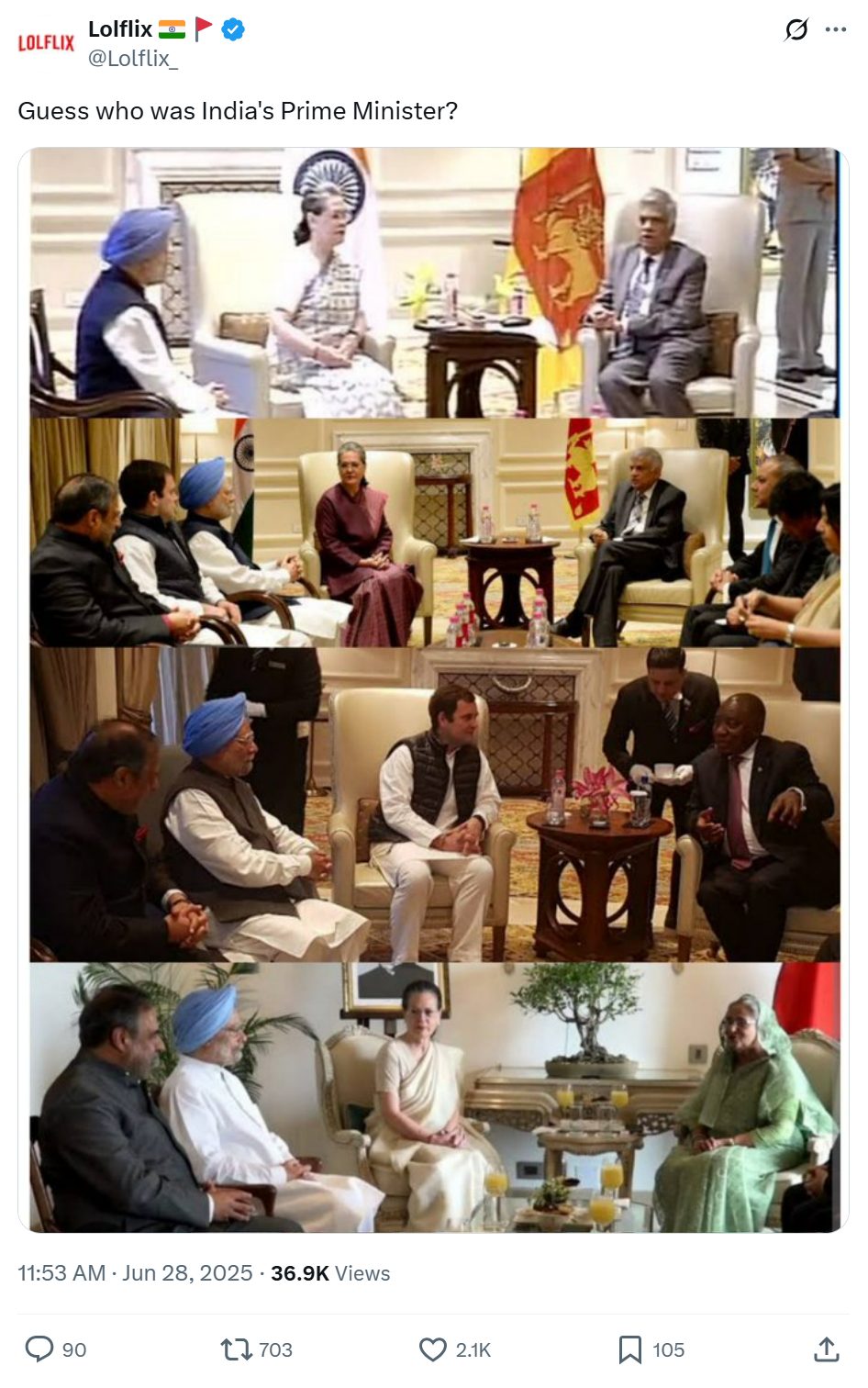
X user Rishi Bagree (@rishibagree), who often shares posts promoting the BJP, also shared the pictures. “The man in the blue turban was India’s Prime Minister for 10 years,” this person wrote in the caption. (Archived link)
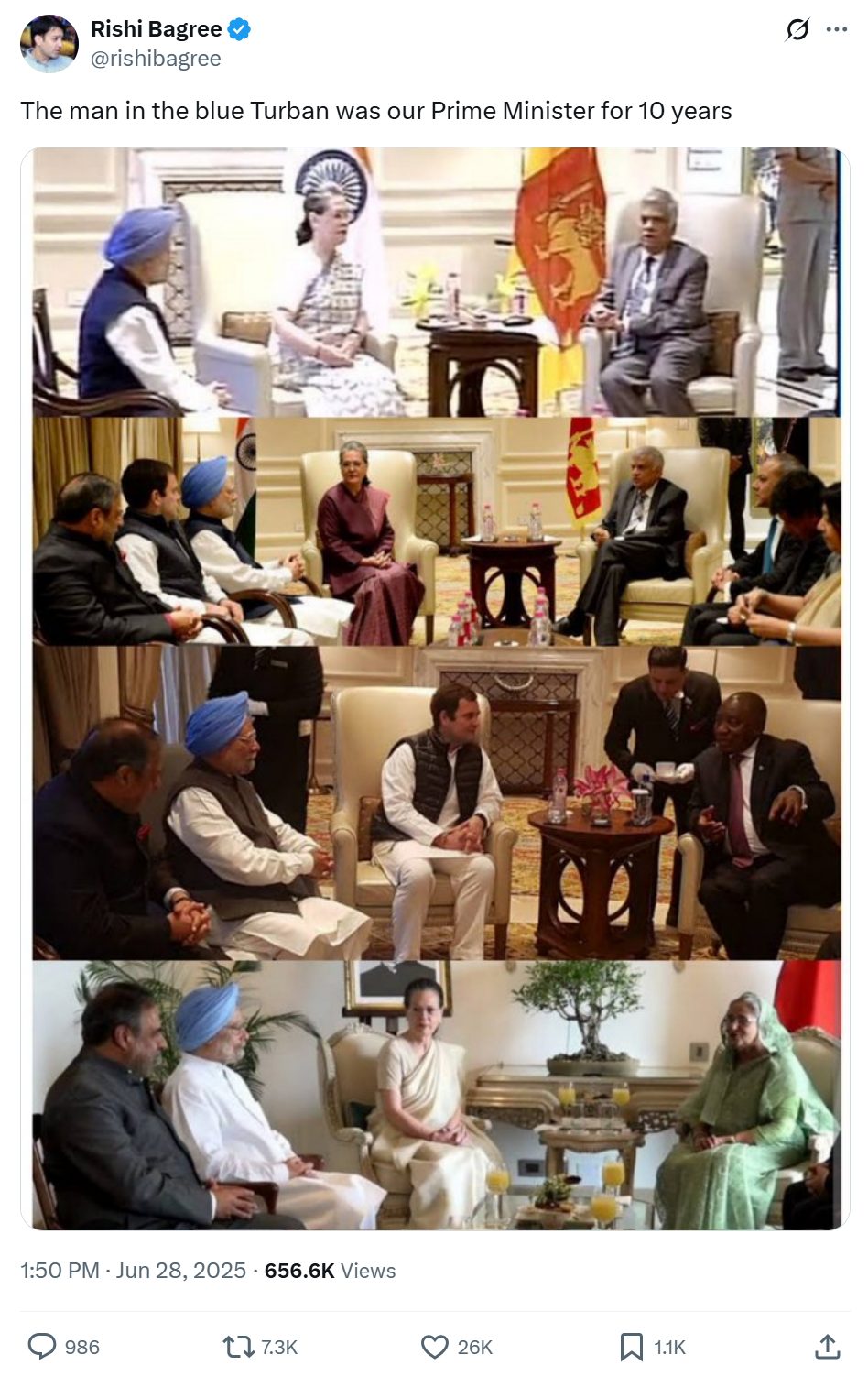
There were a total of four images in the posts by social media users. We looked at each separately.
Image 1: Sri Lankan Prime Minister Ranil Wickremesinghe with Manmohan Singh and Sonia Gandhi
A reverse image search of this picture led us to a post by news agency ANI from April 26, 2017. The accompanying caption said that Sri Lankan Prime Minister Ranil Wickremesinghe met former Prime Minister Manmohan Singh and Sonia Gandhi in New Delhi.
Sri Lankan Prime Minister Ranil Wickremesinghe met former PM Manmohan Singh and Sonia Gandhi in Delhi pic.twitter.com/N5x7OzEeku
— ANI (@ANI) April 26, 2017
Note that the Congress-led United Progressive Alliance was elected to power for a five-year term in 2004 and then again in 2009. So, Manmohan Singh served two terms as Prime Minister—between 2004 and 2014. In other words, this picture is from after Manmohan Singh’s term as PM. At the time, Sonia Gandhi was the Congress president.
Image 2: Sri Lankan PM Wickremesinghe with Manmohan Singh, Sonia Gandhi and Rahul Gandhi
A reverse search of this image led us to an article on The New Indian Express site from November 24, 2017. The report says that Sonia Gandhi and other Congress leaders met Sri Lankan Prime Minister Ranil Wickremesinghe. The report added that she was accompanied by former Prime Minister Manmohan Singh, Congress vice president Rahul Gandhi and the party’s deputy leader in the Rajya Sabha, Anand Sharma.
Thus, this picture is not from Manmohan Singh’s time as Prime Minister. At the time, Sonia Gandhi was the president of Congress.
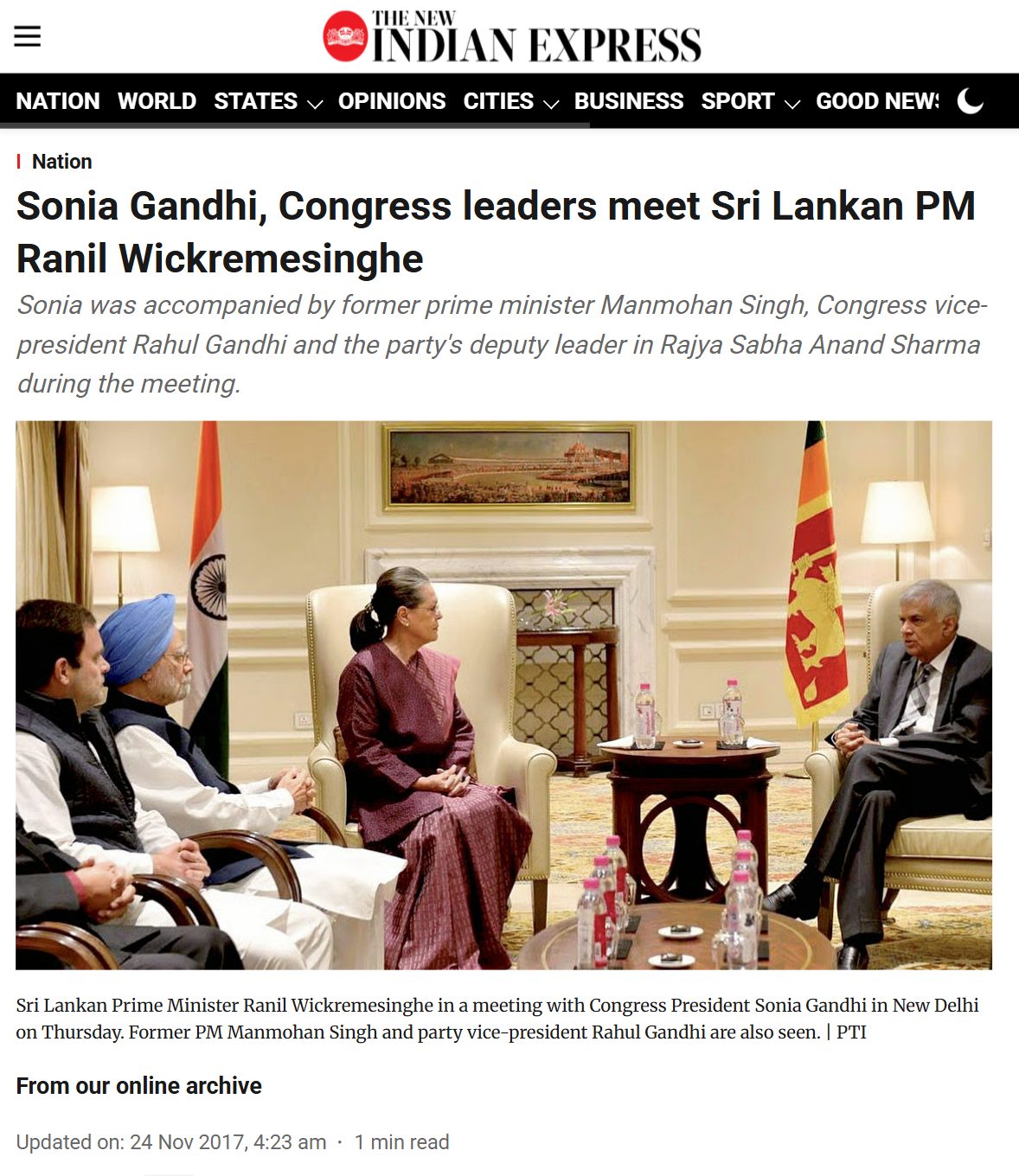
Image 3: South African President Cyril Ramaphosa with Rahul Gandhi and Manmohan Singh
We found the third picture in a National Herald report from January 26, 2019. The image was credited to senior Congress leader Anand Sharma. The report says that Congress president Rahul Gandhi and former Prime Minister Manmohan Singh met South African President Ramaphosa.
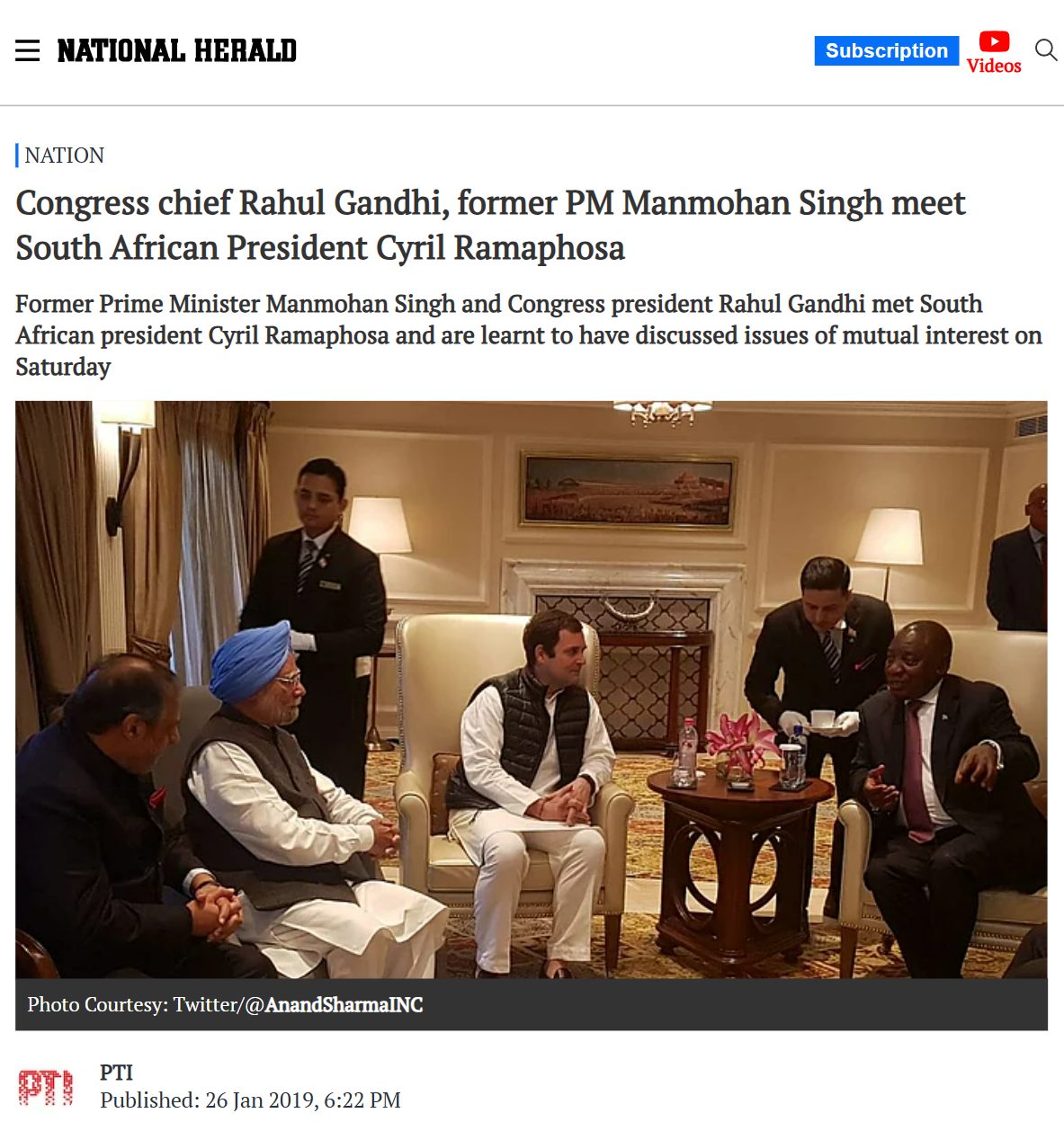
Anand Sharma’s X post from 2019 said that a Congress delegation led by then president Rahul Gandhi and former Prime Minister Manmohan Singh met Ramaphosa. In 2019, Manmohan Singh was neither the PM nor heading the Congress. At the time, Rahul Gandhi was the president of the Opposition party.
Image 4: Bangladesh Prime Minister Sheikh Hasina with Sonia Gandhi, Anand Sharma and Manmohan Singh
After a reverse image search, we found the same image used in a WION report from October 5, 2019. The report states that Bangladesh Prime Minister Sheikh Hasina met Congress President Sonia Gandhi, Priyanka Gandhi Vadra and other party leaders, including Anand Sharma and former PM Manmohan Singh. At this time, Sonia Gandhi was the interim Congress president.

Thus, photos of meetings between foreign delegates and Congress leaders have resurfaced with misleading claims that Manmohan Singh was ignored by Sonia and Rahul Gandhi. These images were after Manmohan Singh’s tenure as PM and were led, on the Congress’s side, by whoever was the party president. Singh was not meeting them as the Indian PM but as a Congress leader.
Since these meetings were between foreign leaders and the Opposition party, Rahul and Sonia Gandhi were seated in the centre as they were the Congress presidents at the time.
The post Did Sonia, Rahul Gandhi ‘disrespect’ ex-PM Manmohan Singh in meetings with foreign leaders? appeared first on Alt News.
This content originally appeared on Alt News and was authored by Abhishek Kumar.
This post was originally published on Radio Free.
Asia Pacific Report
An opposition Labour Party MP today paid tribute to the Nuclear Free and Independent Pacific (NFIP) movement, saying it should inspire Aotearoa New Zealand to maintain its own independence, embrace a strong regionalism, and be a “voice for peace and demilitarisation”.
But Phil Twyford, MP for Te Atatu and spokesperson on disarmament, warned that the current National-led coalition government was “rapidly going in the other direction”.
“It mimics the language of the security hawks in Washington and Canberra that China is a threat to our national interests,” he said.
READ MORE
“That is then the springboard for a foreign policy ‘reset’ under the current government to a closer strategic alignment with the United States and with what are often more broadly referred to as the ‘traditional partners’.
“For that read the Five Eyes members, but particularly the United States.”
Speaking at the opening of the week-long “Legends of the Pacific: Stories of a Nuclear-Free Moana 1975-1995” exhibition at the Ellen Melville Centre, Twyford referred to the 40th anniversary of the Rainbow Warrior bombing by French secret agents on 10 July 2025.
“Much has been made in the years since of what a turning point this was, and how it crystallised in New Zealanders a commitment to the anti-nuclear cause,” he said.
However, he said he wanted to talk about the “bigger regional phenomenon” that shaped activism, public attitudes and official policies across the region, and what it could “teach us today about New Zealand’s place in the world”.
“I am talking about the Nuclear Free and Independent Pacific movement.
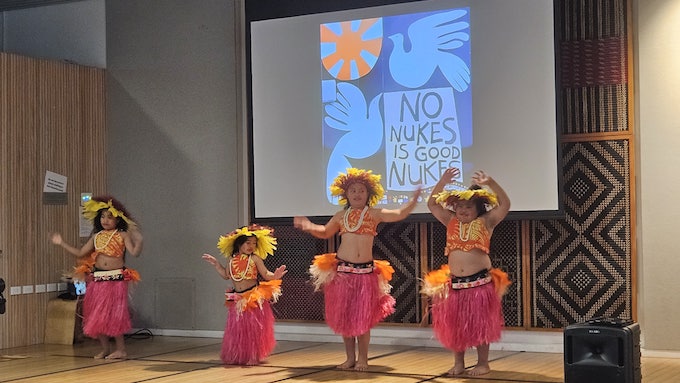
“Activists and leaders from across the Pacific built a movement that challenged neocolonialism and colonialism, put the voices of the peoples of the Pacific front and centre, and held the nuclear powers to account for the devastating legacy of nuclear testing.”
The NFIP movement led to the creation of the Treaty of Rarotonga, the Pacific’s nuclear weapons free zone, Twyford said. It influenced governments and shaped the thinking of a generation.
However, he stressed the “storm clouds” that were gathering as indicated by former prime minister Helen Clark in her prologue to journalist and author David Robie’s new book Eyes of Fire: The Last Voyage and Legacy of the Rainbow Warrior just published this week.
Twyford said that with increasing great power rivalry, the rise of authoritarian leaders, and the breakdown of the multilateral system “the spectre of nuclear war has returned”.
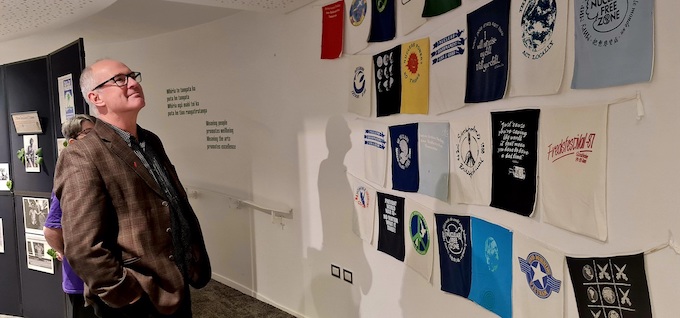
New Zealand faced some stark choices about how it made its way in the world, kept their people and the region safe, and remained “true to the values we’ve always held dear”.
The public debate about the policy “reset” reset had focused on whether New Zealand would be part of AUKUS Pillar Two, “the arrangement to share high end war fighting technology that would sit alongside the first pillar designed to deliver Australia its nuclear submarines”.
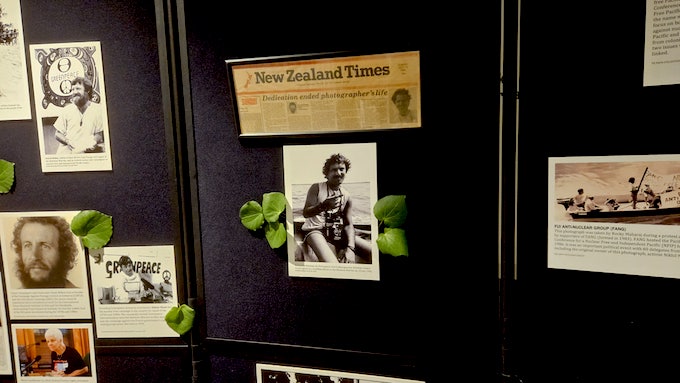
While the New Zealand government had had little to say on AUKUS Pillar Two since the US elections, the defence engagement with the US had “escalated”.
It now included participation in groupings around supply chains, warfighting in space, interconnected naval warfare, and projects on artificial intelligence and cyber capabilities.
China’s growing assertiveness as a great power was not the main threat to New Zealand.
“The biggest threat to our security and prosperity is the possibility of war in Asia between the United States and China,” he said.
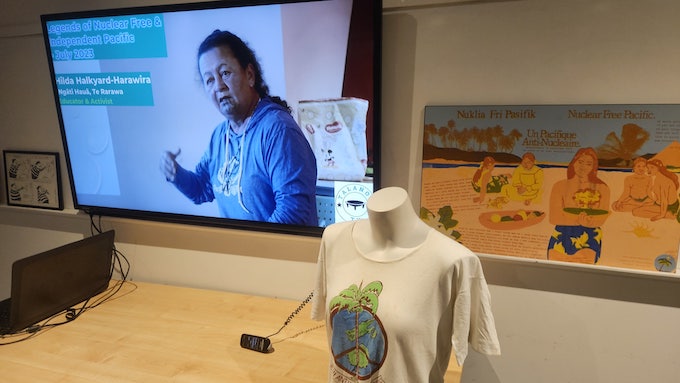
“Rising tensions could conceivably affect trade, and that would be disastrous for us. All-out war, especially if it went nuclear, would be catastrophic for the region and probably for the planet.”
Labour’s view was that security for New Zealand and the Pacific could be pursued through active engagement with the country’s partners across the Tasman and in the Pacific, and Asia — and be a voice for peace and demilitarisation.
Twyford acknowledged Dr Robie’s “seminal book” Eyes of Fire, thanking him for “a lifetime’s work of reporting important stories, exposing injustice and holding the powerful to account”.
Dr Robie spoke briefly about the book as a publishing challenge following his earlier speech at the launch on Thursday.
Other speakers at the opening of the nuclear-free Pacific exhibition included veteran activist such as Reverend Mua Strickson-Pua; Bharat Jamnadas, an organiser of the original Nuclear-Free and Independent Pacific (NFIP) conference in Suva, Fiji, in 1975; businessman and community advocate Nikhil Naidu, previously an activist for the Fiji Anti-Nuclear Group (FANG); and Dr Heather Devere, peace researcher and chair of the Asia Pacific Media Network (APMN).
The Te Vaerua O Te Rangi dance group also performed Cook Islands items.
The exhibition has been coordinated by the APMN in partnership with Heritage New Zealand Pouhere Taonga, with curator Tharron Bloomfield and Antony Phillips; Ellen Melville Centre; and the Whānau Communty Centre and Hub.
It is also supported by Pax Christi, Quaker Peace and Service Fund, and Women’s International League for Peace and Freedom (WILPF).
The exhibition recalls New Zealand’s peace squadrons, a display of activist tee-shirt “flags”, nuclear-free buttons and badges, posters, and other memorabilia. A video storytelling series about NFIP “legends” such as Hilda Halyard-Harawira and Dr Vijay Naidu is also included.
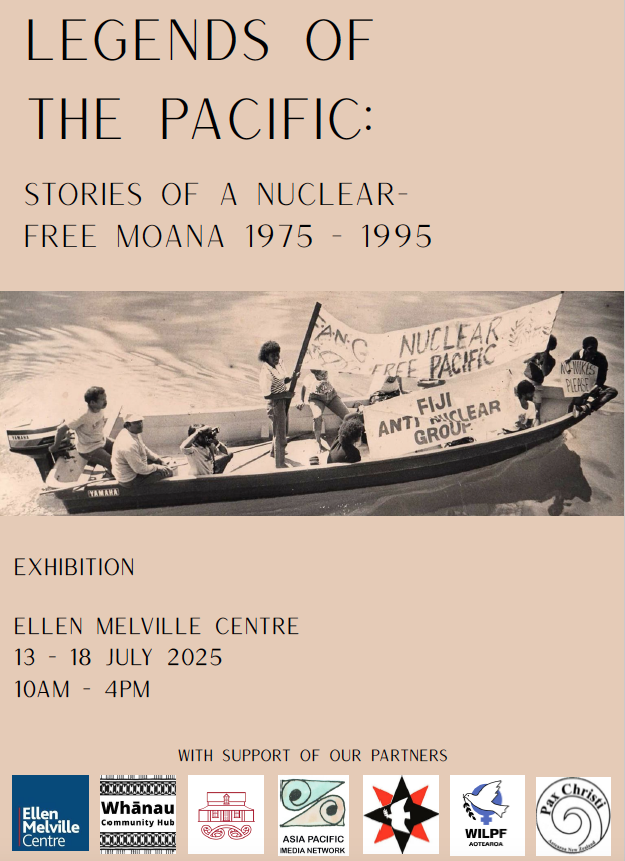
This post was originally published on Asia Pacific Report.
Members of Congress expressed outrage at U.S. Immigration and Customs Enforcement for deceiving eight men who were recently deported to South Sudan, as revealed earlier this week in an investigation by The Intercept. Sen. Bernie Sanders, I-Vt., called the expulsions “abhorrent.”
Before the men boarded a plane in May, officials told them that they were being sent on a short trip from Texas to another ICE facility in Louisiana. Many hours later, the plane landed in Djibouti.
The men — convicted criminals who had already served significant prison sentences — were held in a shipping container for weeks, shackled at the legs, on a U.S. military base in Djibouti. This past weekend, they were expelled to the violence-plagued nation of South Sudan.
The ICE deception revealed by The Intercept highlights the lengths to which the U.S. government will go to further its anti-immigrant agenda and deport people to so-called third countries to which they have no connections.
“Trump’s ICE treats immigrants as less than human, and this is a prime example,” said Rep. Pramila Jayapal, D-Wash., who has been a leading voice on the expulsion of immigrants from the U.S. to third countries, and called ICE’s behavior “beyond cruel.”
“Trump’s ICE treats immigrants as less than human, and this is a prime example.”
Jayapal added: “Yes, any person convicted of serious crimes should be held accountable — but Trump has decided to violate due process rights and ship immigrants to South Sudan, a country so dangerous that the U.S. State Department currently has a ‘Do Not Travel’ warning for it. Third country deportations with no due process are wrong, period, and we will keep fighting these illegal actions in court.”
Rep. Ilhan Omar, D-Minn., also called out the government for its deception. “What ICE did to these men is a flagrant violation of international law and basic human decency,” she told The Intercept. “Lying to people about where they’re being taken and secretly deporting them to a country that is in the midst of war and they have no ties to is cruel.”
Rep. Delia Ramirez, D-Ill., called out President Donald Trump and Department of Homeland Security Secretary Kristi Noem for “blatantly lying to our neighbors as they disappear them to offshore prisons” and for flouting the rule of law, due process, and the Constitution. She called on Noem to resign.
While the eight men were in transit in May — thinking they were heading to Louisiana, but in fact en route to Africa — a federal judge intervened. Citing a prior nationwide injunction requiring the administration to give deportees advance notice of their destination and a “meaningful” chance to object if they believed they’d be in danger of harm, the eight men were not flown directly to South Sudan but were instead diverted to Djibouti.
The Supreme Court ruled on July 3 that the expulsion to South Sudan could go forward.
“The deportation of eight men to South Sudan – a country plagued by famine and brutal civil war – is abhorrent. The Trump administration’s barbaric practice of expelling immigrants to dangerous ‘third countries’ is an abuse of our justice system,” Sanders told The Intercept. “Every person in America is entitled to due process and counsel, regardless of their immigration status or alleged crimes.”
“The Trump administration’s barbaric practice of expelling immigrants to dangerous ‘third countries’ is an abuse of our justice system.”
The Trump administration celebrated the deportations. “After weeks of delays by activist judges that put our law enforcement in danger, ICE deported these 8 barbaric criminals [sic] illegal aliens to South Sudan,” DHS spokesperson Tricia McLaughlin told The Intercept in an email.
“In my district, families were warning us about how rogue and abusive ICE was for years,” Rep. Rashida Tlaib, D-Mich., told The Intercept. “Now they are showing the world how cruel and lawless they are.”
The Intercept sent numerous requests for comment to ICE regarding the lies told to deportees about their supposed transfer to Louisiana. Spokesperson Miguel Alvarez acknowledged receipt of the questions but did not reply.
The men arrived in Juba, South Sudan’s capital, on July 5, and are now “under the care of the relevant authorities, who are screening them and ensuring their safety and well-being,” according to a spokesperson from South Sudan’s Ministry of Foreign Affairs and International Cooperation.
South Sudan is subject to a United Nations warning about the potential for full-scale civil war. The State Department advises those who travel to South Sudan to draft a will, establish a proof of life protocol with family members, and leave DNA samples with one’s medical provider.
“The conditions in South Sudan are bad enough that we shouldn’t be deporting South Sudanese people there, let alone sending noncitizens who have never lived there and have no support system on the ground,” said Omar. “This agency has repeatedly shown that it cannot be trusted to uphold human rights. ICE is beyond reform and should be abolished. We need to start imagining what real justice and humane immigration policy actually looks like.”
“ICE is beyond reform and should be abolished. We need to start imagining what real justice and humane immigration policy actually looks like.”
South Sudan’s foreign ministry said they had received the deportees amid “ongoing bilateral engagement” between Juba and the Trump administration. The agreement to accept the eight men was “part of a broader framework of cooperation, both countries continue to engage constructively and with good faith on a range of matters, including political, economic, investment, security, humanitarian, and consular-related issues,” according to the spokesperson. “This engagement aims at normalizing relations, deepening bilateral cooperation, and addressing issues of mutual concern and interest.”
South Sudan is just the latest nation where the U.S. has expelled immigrants with no ties to that country. The Trump administration began using the notorious Terrorism Confinement Center in Tecoluca, El Salvador, as a foreign prison to disappear Venezuelan immigrants in March. The Intercept found that the U.S. has already explored deals with more than a quarter of the world’s nations to accept so-called third-country nationals. It has been employing strong-arm tactics with dozens of smaller, weaker, and economically dependent nations to expand its global gulag for expelled immigrants.
“From Guantanamo to El Salvador, Djibouti, and South Sudan, the use of offshore prisons is criminal, inhumane, wasteful, and dangerous,” Ramirez told The Intercept. “The Administration knows it, and they continue to lie to cover up their unlawful actions.”
The deals are being conducted in secret, and neither the State Department nor ICE will discuss them. With the green light from the Supreme Court, thousands of immigrants are in danger of being disappeared into this network of deportee dumping grounds.
The State Department, as usual, offered a disingenuous boilerplate response that cast the agreement with South Sudan as theoretical. “In some cases, we might work with other countries to facilitate the removal from the United States of nationals of third countries who have no legal basis to remain here,” said a spokesperson.
This spring, Secretary of State Marco Rubio announced the revocation of all visas for South Sudanese passport holders, and blocked the issuance of new visas, citing the country’s refusal to “accept the return of its repatriated citizens in a timely manner.”
Edmund Yakani, a longtime human rights defender in South Sudan and executive director of the Community Empowerment for Progress Organization, called on his government to safeguard the eight men. “We urge our government not to use the eight deportees as bargaining chips,” he told The Intercept, imploring Juba to provide information on the condition of the men and the next steps awaiting them.
The post House Democrat Calls on Kristi Noem To Resign Over ICE Lies appeared first on The Intercept.
This post was originally published on The Intercept.
Comprehensive coverage of the day’s news with a focus on war and peace; social, environmental and economic justice.

A man hugs former Foreign Service employee Bob Gilchrist, of Washington, left, outside the State Department headquarters, Friday, July 11, 2025, in Washington. (AP Photo/Mark Schiefelbein).
The post State Department fired more than 1,300 in sweeping Trump administration reorganization – July 11, 2025 appeared first on KPFA.
This content originally appeared on KPFA – The Pacifica Evening News, Weekdays and was authored by KPFA.
This post was originally published on Radio Free.
Asia Pacific Report
Nuclear-free and independent Pacific advocates are treating Aucklanders to a lively week-long exhibition dedicated to the struggle for nuclear justice in the region.
It will be opened today by the opposition Labour Party’s spokesperson on disarmament and MP for Te Atatu, Phil Twyford, and will include a range of speakers on Aotearoa New Zealand’s record as a champion of a nuclear-free Pacific and an independent foreign policy.
Speaking at a conference last month, Twyford said the country could act as a force for peace and demilitarisation, working with partners across the Pacific and Asia and basing its defence capabilities on a realistic assessment of threats.
The biggest threat to the security of New Zealanders was not China’s rise as a great power but the possibility of war in Asia, Twyford said.
Although there have been previous displays about the New Zealand nuclear-free narrative, this one has a strong focus on the Pacific.
it is called the “Legends of the Pacific: Stories of a Nuclear-free Moana 1975-1995” and will run from tomorrow, July 13 until Friday, July 18.
Veteran nuclear-free Pacific spokespeople who are expected to speak at the conference include Reverend Mua Strickson-Pua; Bharat Jamnadas, an organiser of the original Nuclear-Free and Independent Pacific (NFIP) conference in Suva, Fiji, in 1975; businessman and community advocate Nikhil Naidu, previously an activist for the Fiji Anti-Nuclear Group (FANG) and Dr Heather Devere, peace researcher and chair of the Asia Pacific Media Network (APMN).
A group of Cook Islands young dancers will also take part.
Knowledge to children
One of the organisers, Nik Naidu, told Asia Pacific Report, it was vital to restore the enthusiasm and passion around the NFIP movement as in the 1980s.
“It’s so important to pass on our knowledge to our children and future generations,” he said.
“And to tell the stories of our on-going journey and yearning for true independence in a world free of wars and weapons of mass destruction. This is what a Nuclear-Free and Independent Pacific is.”
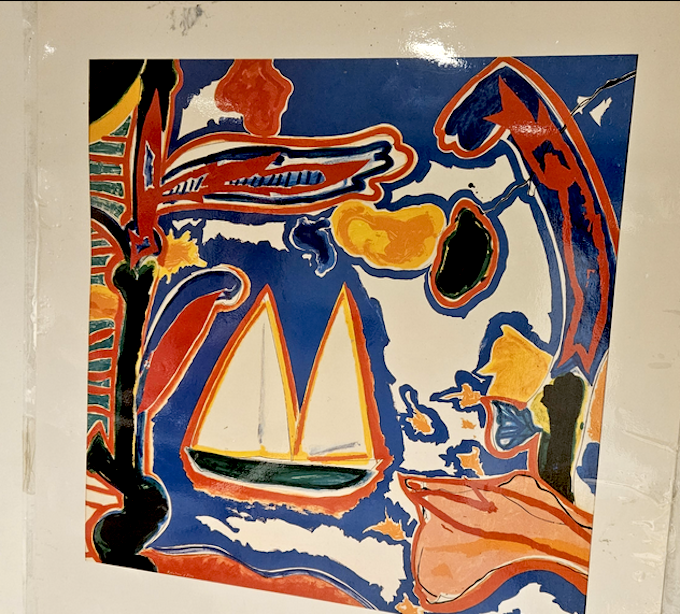
The exhibition is is coordinated by the APMN in partnership with the Heritage New Zealand Pouhere Taonga, with curator Tharron Bloomfield and coordinator Antony Phillips; Ellen Melville Centre; and the Whānau Communty Centre and Hub.
It is also supported by Pax Christi, Quaker Peace and Service Fund, and Women’s International League for Peace and Freedom (WILPF).
It recalls New Zealand’s peace squadrons, a display of activist tee-shirt “flags”, nuclear-free buttons and badges, posters, and other memorabilia.
Timely exhibition
Author Dr David Robie, deputy chair of the APMN, who wrote the book Eyes of Fire: The Last Voyage and Legacy of the Rainbow Warrior just published on Thursday, and dedicated to the NFIP movement, said the the exhibition was timely.
“It is a sort of back to the future situation where the world is waking up again to a nuclear spectre not really seen since the Cold War years,” he said.
“With the horrendous Israeli genocide on Gaza — it is obscene to call it a war, when it is continuous massacres of civilians; the attacks by two nuclear nations on a nuclear weapons-free country, as is the case with Iran; and threats against another nuclear state, China, are all extremely concerning developments.”
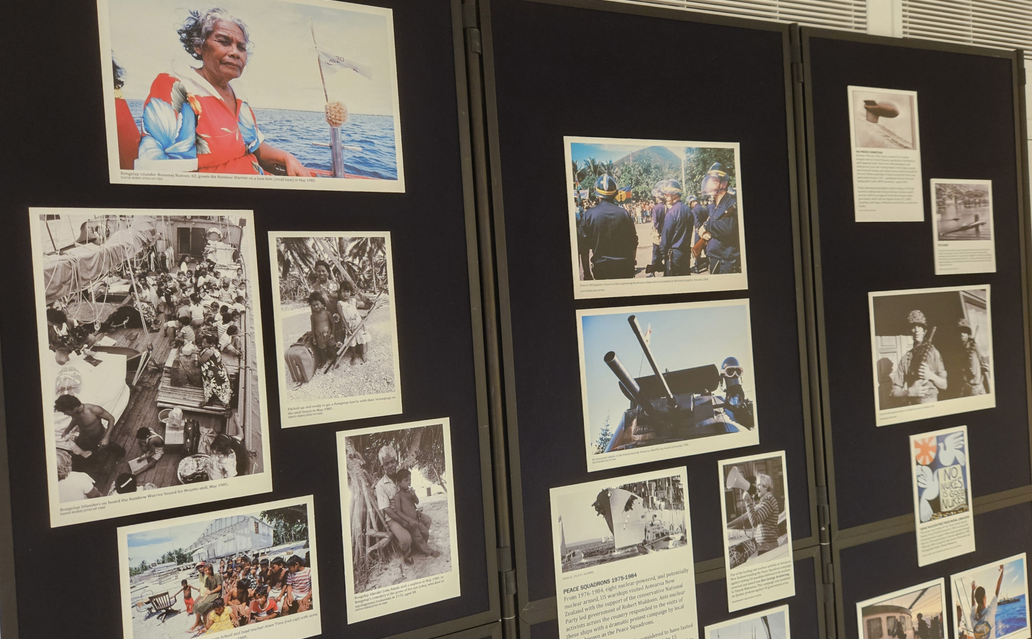
This post was originally published on Asia Pacific Report.
This content originally appeared on Democracy Now! and was authored by Democracy Now!.
This post was originally published on Radio Free.
President Donald Trump’s administration has vanished another inconvenient fact: the number of transgender people in immigration detention.
Immigration and Customs Enforcement quietly stopped reporting how many transgender people it keeps locked up in February, as the total population of immigrants in detention soared and the agency rescinded protections for trans people.
The move follows Trump’s executive order in January to essentially stop recognizing that trans people exist. According to the nonprofit Vera Institute of Justice, it appears to run afoul of a congressional mandate to report how many transgender and other vulnerable people are being kept in immigration detention.
The move has complicated advocates’ efforts to keep trans immigrants safe behind bars, where they face a heightened risk of violence and medical neglect.
“It’s part and parcel of a larger effort to really erase trans people,” said Bridget Crawford, the director of law and policy for the nonprofit advocacy group Immigration Equality. “They are not even willing to try to track the trans population, despite the congressional mandate.”
Her group released a survey last year finding “systemic” mistreatment of LGBTQ+ and HIV-positive people in immigration detention. About one third of the respondents reported sexual and physical abuse or harassment, and nearly all reported verbal abuse, including threats of violence. Most said they received inadequate medical care or were denied care outright.
“Advocates and legal service providers rely on these statistics, even though the statistics are limited.”
Congress directed the Department of Homeland Security, the parent agency of ICE, to report the number of transgender people in detention starting in 2021, according to the Vera Institute.
The data that ICE published to its website under former President Joe Biden only gave a breakdown on the number of trans people in broad geographic regions. Still, it showed a climb in the number of people self-identifying as transgender from a handful in 2021 to as many as 60 last year.
That number was almost certainly an undercount, experts say, since transgender people are reluctant to divulge their identity to officials for any number of reasons. Nevertheless, it provided advocates with an idea of where to point their resources and helped them pressure ICE to provide more resources.
“Advocates and legal service providers rely on these statistics, even though the statistics themselves are limited,” said Noelle Smart, a researcher for the Vera Institute.
Without regular data, there’s no way to know for sure if the number of transgender people in ICE detention has risen along with the overall population, but it seems likely, Smart said.
“We know in general that transgender people are more likely to encounter the criminal legal system, which is a major way that people encounter immigration enforcement, through over-policing,” she said.
Other politically inconvenient information has also gone missing from ICE’s website under Trump. In 2015, when Trump border czar Tom Homan was an agency executive under then-President Barack Obama, he signed a memorandum on care for transgender people in ICE custody. It is no longer available to download.
The page that previously hosted the document now pulls up a “Page Not Found” notice. The memo disappeared from public view in February, shortly after the New York Times published an article on Homan’s career that highlighted his creation of it.
When Tom Homan worked for ICE under Obama, he signed a memo on care for trans people in custody. It is no longer available.
Homan has claimed that he was pressured to sign the memo.
ICE did not respond to a request for comment about why the memo is no longer available or whether it remains in effect.
The agency has also stripped out language protecting trans people from the contracts for three detention facilities, as The Intercept reported in March.
Last month, it deleted references to transgender people from its national detention standards, further alarming advocates.
“The broader context is quite alarming, especially because the vast majority of our clients have very, very strong asylum claims,” Crawford said. “The vast, overwhelming majority have experienced very high levels of abuse, sexual assault, often torture before they come to the United States.”
The post Trans People Have Disappeared From ICE Records, Against Congressional Orders appeared first on The Intercept.
This post was originally published on The Intercept.
Social media users recently shared a video claiming that slogans of ‘Pakistan Zindabad’ were raised by Muslims participating in a Muharram procession in Uttar Pradesh. The viral posts also contain derogatory words against the Muslim community.
X user Deepak Sharma, who regularly shares disinformation and promotes communal propaganda, shared the video tagging the Deoria Police and wrote, “Do you hear what I am hearing? This crowd raising slogans of ‘Pakistan Zindabad’ is not in Pakistan but in India, that too in India’s Uttar Pradesh. Betrayal is in their blood.”
पाकिस्तान जिंदाबाद
जी हाँ ये पाकिस्तान जिंदाबाद क़े नारे लगाती ये भीड़ पाकिस्तान में नहीं भारत में है और भारत क़े
भी उत्तर प्रदेश में हैखून में ही गद्दारी इन BSD वाले लोगों क़े…
Hello @DeoriaPolice
क्या आप वो सुन पा रहे हैं जो मैं सुन रहा हूँ ?इन्हे ऐसा सबक सिखाएं कि… pic.twitter.com/IDKdnM7jW3
— Deepak Sharma (@SonOfBharat7) July 7, 2025
Right-wing X user Sandeep Mishra and several others on other platforms like Instagram and Facebook shared the same footage with claims that ‘Pakistan Zindabad’ slogans had been raised during a Muharram procession.
Alt News found that the official X handle of the Deoria Police had tweeted about this and refuted the claim about ‘Pakistan Zindabad’ slogans being raised. According to police, in the video recorded during a Muharram procession by the Five Star Club, slogans of ‘Five Star Zindabad’, and not ‘Pakistan Zindabad’ could be heard.
The police also mentioned that the procession was carried out peacefully in police presence.
मोहर्रम त्यौहार के दिनांक 06/07.07.2025 के जुलूस के दौरान सोशल मीडिया पर एक भ्रामक तरीके से प्रसारित किए जा रहे वीडियो के सम्बन्ध में देवरिया पुलिस का खण्डन।#UPPolice @diggorakhpur @AdgGkr @dgpup @UPPViralCheck pic.twitter.com/7uo0AajvLe
— DEORIA POLICE (@DeoriaPolice) July 7, 2025
Alt News examined the video by playing it in slow motion. On listening carefully to the slogans being raised in the procession, it became clear that the chants were not that of ‘Pakistan Zindabad’, but ‘Five Star Zindabad’. However, due to the background noise, the slogans are not that clear.
Apart from this, we noticed that many people participating in the procession wore green T-shirts with ‘5 STAR CLUB’ and ‘5 star’ printed on them.

Upon further investigation, we also came across the Instagram page of 5 star club. Many videos taken during Muharram can be found on this page. Apart from these, in a post by Instagram user Israfil Ansari, too, members of the 5 Star Club can be seen participating in Muharram observation wearing the same green T-shirts in the presence of police personnel.
View this post on Instagram
To sum it up, slogans of “Five Star Zindabad” were raised in the video in question. However, some users falsely claimed that Muslims were raising ‘Pakistan Zindabad’ slogans during Muharram.
The post No, Pakistan Zindabad slogans were not raised at Muharram rally in Deoria, Uttar Pradesh appeared first on Alt News.
This content originally appeared on Alt News and was authored by Pawan Kumar.
This post was originally published on Radio Free.
Asia Pacific Report
A journalist who was on the Rainbow Warrior voyage to Rongelap last night condemned France for its “callous” attack of an environmental ship, saying “we haven’t forgotten, or forgiven this outrage”.
David Robie, the author of Eyes of Fire: The Last Voyage and Legacy of the Rainbow Warrior, said at the launch that the consequences of almost 300 US and French nuclear tests – many of them “dirty bombs” — were still impacting on indigenous Pacific peoples 40 years after the bombing of the ship.
French saboteurs had killed “our shipmate Fernando Pereira” on 10 July 1985 in what the New Zealand prime minister at the time, David Lange, called a “sordid act of international state-backed terrorism”.
Although relations with France had perhaps mellowed over time, four decades ago there was a lot of hostility towards the country, Dr Robie said.
“And that act of mindless sabotage still rankles very deeply in our psyche,” he said at the launch in Auckland Central’s Ellen Melville Centre on the anniversary of July 10.
About 100 people gathered in the centre’s Pioneer Women’s Hall for the book launch as Dr Robie reflected on the case of state terrorism after Greenpeace earlier in the day held a memorial ceremony on board Rainbow Warrior III.
“One of the celebrated French newspapers, Le Monde, played a critical role in the investigation into the Rainbow Warrior affair — what I brand as ‘Blundergate’, in view of all the follies of the bumbling DGSE spy team,” he said.
Plantu cartoon
“And one of the cartoons in that newspaper, by Plantu, who is a sort of French equivalent to Michael Leunig, caught my eye.
“You will notice it in the background slide show behind me. It shows François Mitterrand, the president of the French republic at the time, dressed in a frogman’s wetsuit lecturing to school children during a history lesson.
“President Mitterrand says, in French, ‘At that time, only presidents had the right to carry out terrorism!’
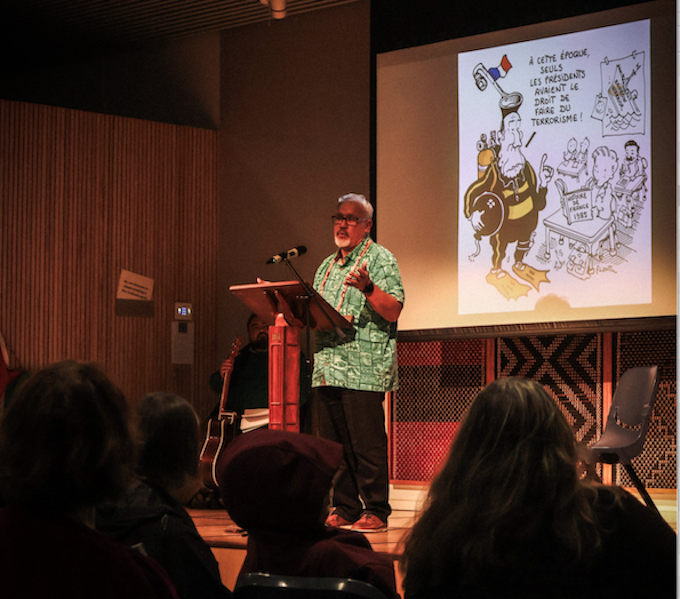
He noticed that in the Mitterrand cartoon there was a “classmate” sitting in the back of the room with a moustache. This was none other than Edwy Plenel, the police reporter for Le Monde at the time, who scooped the world with hard evidence of Mitterrand and the French government’s role at the highest level in the Rainbow Warrior sabotage.
Dr Robie said that Plenel now published the investigative website Mediapart, which had played a key role in 2015 revealing the identity of the bomber that night, “the man who had planted the limpet mines on the Rainbow Warrior — sinking a peace and environmental ship, and killing Fernando Pereira.”
Jean-Luc Kister, a retired French colonel and DGSE secret agent, had confessed to his role and “apologised”, claiming the sabotage operation was “disproportionate and a mistake”.
“Was he sincere? Was it a genuine attempt to come to terms with his conscience. Who knows?” Dr Robie said, adding that he was unconvinced.
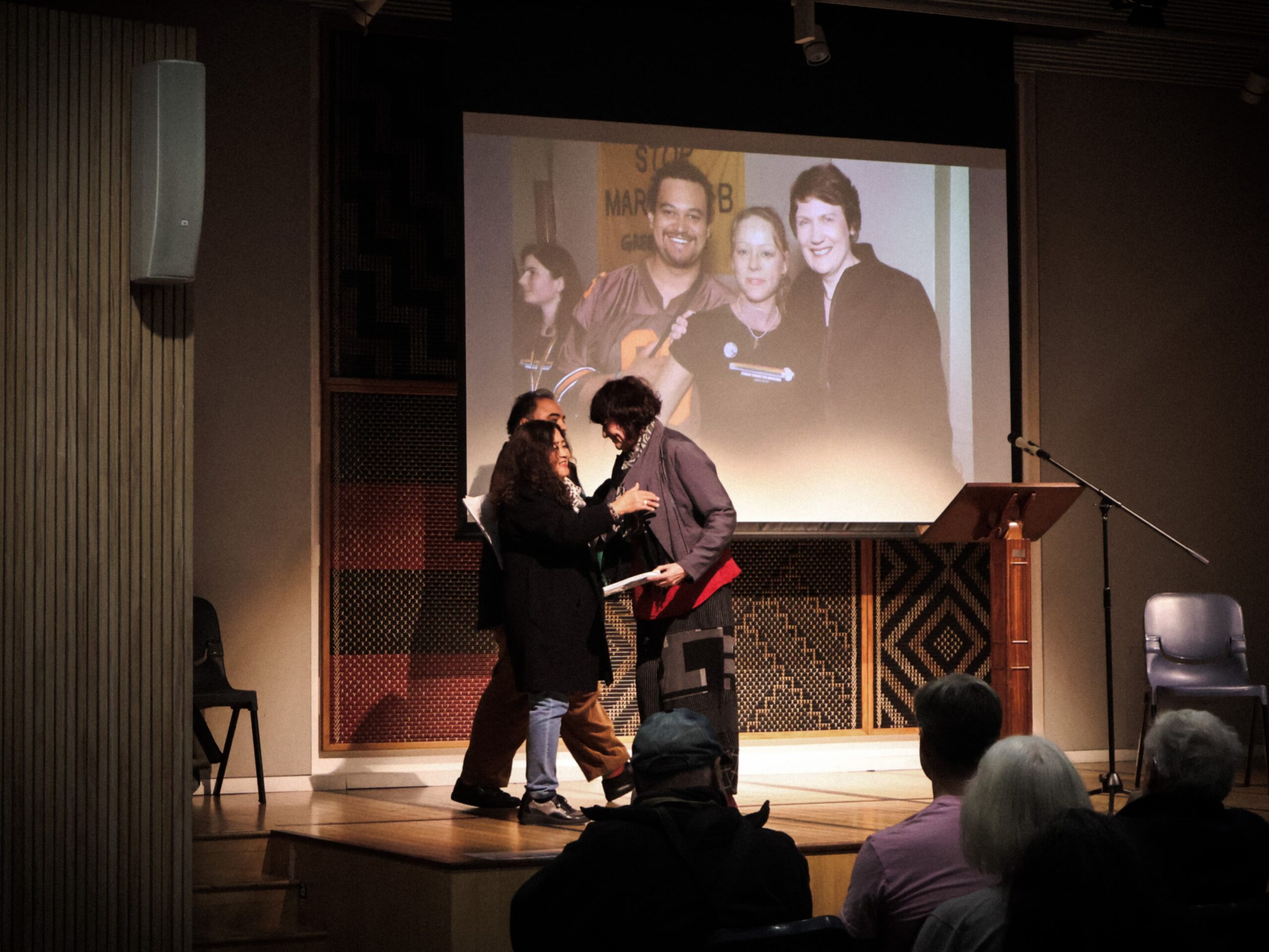
French perspective
Dr Robie said he had asked Plenel for his reflections from a French perspective 40 years on. Plenel cited three main take ways.
“First, the vital necessity of independent journalism. Independent of all powers, whether state, economic or ideological. Journalism that serves the public interest, the right to know, and factual truths.
“Impactful journalism whose revelations restore confidence in democracy, in the possibility of improving it, and in the usefulness of counterbalancing powers, particularly journalism.”
Secondly, this attack had been carried out by France in an “allied country”, New Zealand, against a civil society organisation. This demonstrated that “the thirst for power is a downfall that leads nations astray when they succumb to it.
“Nuclear weapons epitomise this madness, this catastrophe of power.”
Finally, Plenel expressed the “infinite sadness” for a French citizen that after his revelations in Le Monde — which led to the resignations of the defence minister and the head of the secret services — nothing else happened.
“Nothing at all. No parliamentary inquiry, no questioning of François Mitterrand about his responsibility, no institutional reform of the absolute power of the president in a French republic that is, in reality, an elective monarchy.”
‘Elective monarchy’ trend
Dr Robie compared the French outcome with the rapid trend in US today, “a president who thinks he is a monarch, a king – another elective monarchy.”
He also bemoaned that “catastrophe of power” that “reigns everywhere today – from the horrendous Israeli genocide in Gaza to the Russian invasion of Ukraine, from Trump to Putin to Netanyahu, and so many others.”
The continuous Gaza massacres were a shameful indictment of the West that had allowed it to happen for more than 21 months.
Dr Robie thanked many collaborators for their help and support, including drama teacher Hilari Anderson, an original crew member of the Rainbow Warrior, and photographer John Miller, “who have been with me all the way on this waka journey”.
He thanked his wife, Del, and family members for their unstinting “patience and support”, and also publisher Tony Murrow of Little Island Press.
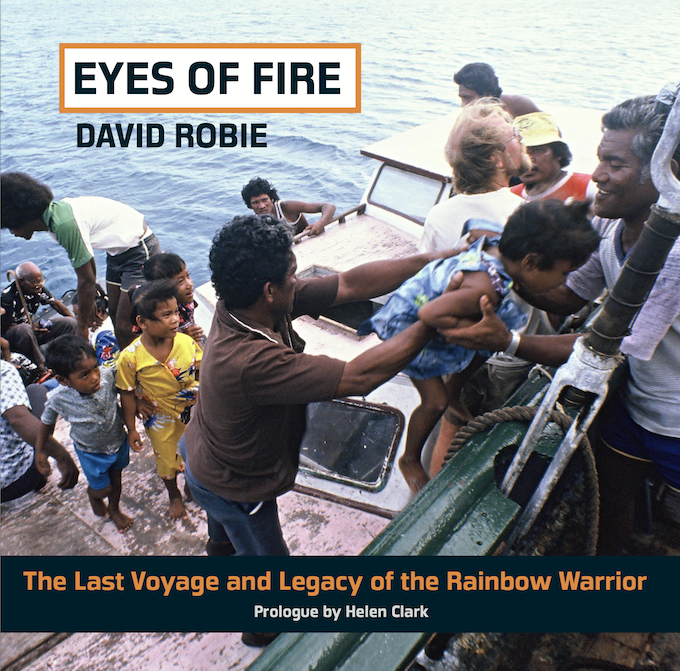
Launching the book, Greenpeace Aotearoa programme director Niamh O’Flynn said one thing that had stood out for her was how the legacy of the Rainbow Warrior had continued despite the attempt by the French government to shut it down 40 years ago.
“We said then that ‘you can’t sink a rainbow’, and we went on to prove it.
“When the Rainbow Warrior was bombed in Auckland harbour, it was getting ready to set sail to Moruroa Atoll, to enter the test exclusion zone and confront French nuclear testing head-on.”
So threatened
The French government had felt so threatened by that action that it had engaged in a state-sanctioned terror attack to prevent the mission from going ahead.
“But we rebuilt, and the Rainbow Warrior II carried on with that mission, travelling to Moruroa three times before the French finally stopped nuclear testing in the Pacific.
“That spirit and tenacity is what makes Greenpeace and what makes the Rainbow Warrior so special to everyone who has sailed on her,” she said.
“It was the final voyage of the Rainbow Warrior to Rongelap before the bombing that is the focus of David Robie’s book, and in many ways, it was an incredibly unique experience for Greenpeace — not just here in Aotearoa, but internationally.
“And of course David was a key part in that.”
O’Flynn said that as someone who had not even been born yet when the Rainbow Warrior was bombed, “I am so grateful that the generation of nuclear-free activists took the time to pass on their knowledge and to build our organisation into what it is today.
“Just as David has by writing down his story and leaving us with such a rich legacy.”
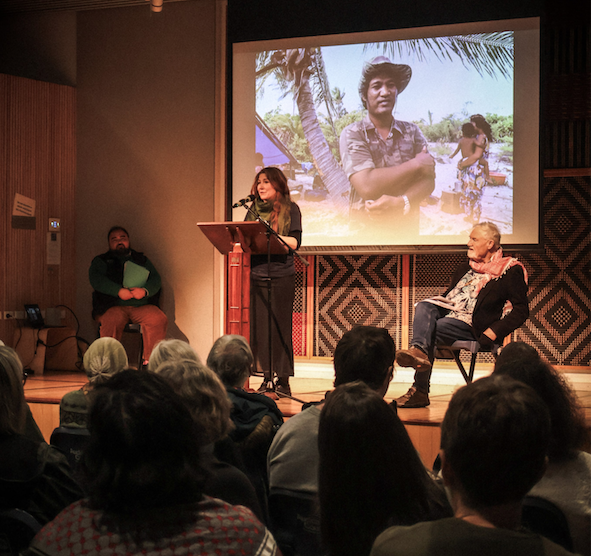
Other speakers
Among other speakers at the book launch were teacher Hilari Anderson, publisher Tony Murrow of Little Island Press, Ena Manuireva, a Mangarevian scholar and cultural adviser, and MC Antony Phillips of Heritage New Zealand Pouhere Taonga.
Anderson spoke of the Warrior’s early campaigns and acknowledged the crews of 1978 and 1985.
“I have been reflecting what these first and last crews of the original Rainbow Warrior had in common, realising that both gave their collective, mostly youthful energy — to transformation.
“This has involved the bonding of crews by working hands-on together. Touching surfaces, by hammer and paint, created a physical connection to this beloved boat.”
She paid special tribute to two powerful women, Denise Bell, who tracked down the marine research vessel in Aberdeen that became the Rainbow Warrior, and the indomitable Susi Newborn, who “contributed to naming the ship and mustering a crew”.
Manuireva spoke about his nuclear colonial experience and that of his family as natives of Mangareva atoll, about 400 km from Muroroa atoll, where France conducted most of its 30 years of tests ending in 1995.
He also spoke of Tahitian leader Oscar Temaru’s pioneering role in the Nuclear-Free and Independent Pacific (NFIP) movement, and played haunting Tahitian songs on his guitar.
This post was originally published on Asia Pacific Report.
Comprehensive coverage of the day’s news with a focus on war and peace; social, environmental and economic justice.
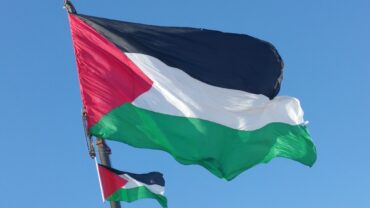
The post US sanctions top UN human rights official on Occupied Palestinian Territory; Judge pauses Trump order ending birthright citizenship – July 10, 2025 appeared first on KPFA.
This content originally appeared on KPFA – The Pacifica Evening News, Weekdays and was authored by KPFA.
This post was originally published on Radio Free.
On July 5, 2025, the Press Information Bureau (PIB)—the official media and public relations arm of the Indian government—published a press release titled “World Bank Places India Among World’s Most Equal Societies.” Citing a World Bank report, PIB published a misleading claim that “India ranks fourth globally in income equality with a Gini score of 25.5,” after the Slovak Republic, Slovenia, and Belarus.
Click to view slideshow.After PIB’s release, several media outlets, including Times of India, Moneycontrol, The Hindu, Mint, Deccan Herald, Indian Express and Republic published reports that India ranked fourth in terms of income equality, with some directly attributing it to the World Bank. Among them, The Hindu and Deccan Herald had PTI copies while Mint had an ANI copy. Largely, they all parroted the PIB release.
Also Read | Op Sindoor: As Indian media made false, outrageous claims, PIB looked the other way
Click to view slideshow.Comparing India’s Gini score (25.2) with the United Kingdom (32.4), the United States (41.8) and China (35.7), PIB said that India’s income equality outshone major economies.
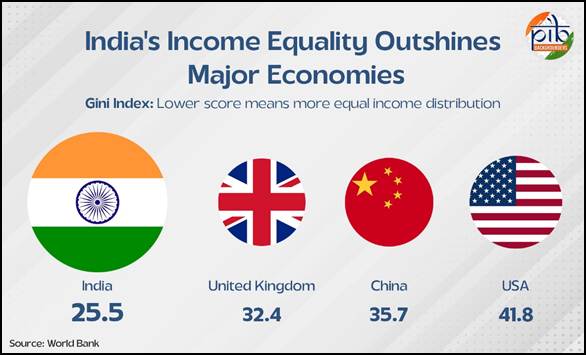
The World Bank defines the Gini as an index that measures the “extent to which the distribution of income or consumption among individuals or households within an economy deviates from a perfectly equal distribution”. A Gini score or coefficient is expressed as a percentage. The number 0 denotes a perfectly equal society (where everyone has the same level of income or consumption), while a score of 100 denotes extreme inequality (where some have nothing and the rest have all).
However, the PIB seems to have cherry picked some information from the World Bank report and misrepresented it.
Here’s what the World Bank’s April 2025 Poverty & Equity Brief for India says:
“…India’s consumption-based Gini index improved from 28.8 in 2011-12 to 25.5 in 2022-23, though inequality may be underestimated due to data limitations. In contrast, the World Inequality Database shows income inequality rising from a Gini of 52 in 2004 to 62 in 2023. Wage disparity remains high, with the median earnings of the top 10 percent being 13 times higher than the bottom 10 percent in 2023-24…”
So, there are two Ginis—one based on consumption and the other on income. Clearly, the World Bank says that India has improved in one and done worse in the other.
But PIB has compared the consumption-based Gini score of India (where India fares slightly better in 2022-23 than 2011-12) with the income-based Gini scores of UK, US, Slovenia and Slovak Republic (where India is worse off now than before).
The World Bank itself warns against comparing Gini coefficients of different countries for this very reason, because the underlying data used in surveys for these calculations varies. Note that the World Bank does not collect data itself; it measures inequality based on household survey data provided by governments. From the World Bank glossary:
“Because the underlying household surveys differ in methods and types of welfare measures collected, data are not strictly comparable across countries or even across years within a country.”
The reason such a comparison is problematic follows:
“… Surveys can differ in many respects, including whether they use income or consumption expenditure as the living standard indicator. The distribution of income is typically more unequal than the distribution of consumption.”
So, in comparing India’s consumption inequality with more developed countries’ income inequality, we are essentially comparing two different units. And inequality based on consumption data will, by default, appear more equal.
Let’s understand why this is so.
Most developed, wealthy or high-income countries use income-based household surveys because their economies are formalised and tracking incomes is not a challenge. Developing, middle and lower-income groups use consumption-based household surveys owing to challenges with collecting data on incomes (some reasons could be a sizeable proportion of the labour force being deployed in informal sectors, more cash transactions, less access to banking, etc).
But when we track inequality based on the two different surveys, the results are different. Countries that use income-based surveys appear to be more unequal. There are three main reasons for this:
First, income-based surveys include all means through which one earns (such as salary, capital gains, additional earnings) whereas consumption-based surveys take account only of households’ expenditure. To put it another way, one measures a household’s potential purchasing power while the other only measures how much is actually used or spent. While those with higher incomes may consume more, they also have a greater propensity to save. So, just looking at households’ consumption data cannot give us a clear picture of their potential purchasing power.
Let’s take an oversimplified example. A poor household spends around Rs 15,000 a month or 75% of its income, while a wealthy household spends Rs 50,000, which is 10% of its monthly income. At a glance, just based on their expenditure or consumption, it is hard to gauge the level of inequality between the two, even when there is a significant difference in their spending. But if we conflate their monthly incomes—Rs 20,000 and Rs 5 lakh, respectively—the level of inequality is stark.
Two, according to a 2024 paper on the Gini coefficient titled “The World Bank’s New Inequality Indicator: The Number of Countries with High Inequality” (Haddad et al.) households’ incomes can sometimes be extremely low or even negative, due to unemployment, loss in business, or other temporary shocks but they would still need to maintain a basic level of consumption for sustenance. This keeps consumption levels from falling sharply.
Three, wealthier households have a greater propensity to save. As incomes grow, the proportion of what is spent on essentials diminishes and the proportion devoted to savings rises. For instance, a household might receive a large one-time income from investments but won’t necessarily spend all of it right away. Instead, they may save most of it for future needs or emergencies.
Because of these differences, income and consumption inequality are not directly comparable—income can fluctuate sharply, while consumption tends to be smoother since everyone depends on at least a minimum level of subsistence.
The Press Information Bureau took the 25.5 figure, which is the consumption-based Gini and compared it with the income-based Gini of the United States of America and the United Kingdom. It also claimed that India stands fourth globally in income equality, after the Slovak Republic, Slovenia and Belarus.
As established earlier, income inequality is typically higher than consumption inequality. This means that when the Gini for a country is calculated using income data, it will appear more unequal and thus have a higher score than when it is calculated using consumption data.
Like we mentioned before, this is similar to comparing absolute numbers of different units. For instance, it’s like saying 100 grams is more than 50 ounces. What is comparable, however, is India’s income-based Gini, which is 62, much higher than those of the UK and the USA.
We’ve ranked the countries mentioned in the PIB press release below, distinguishing their most recent available consumption-based and income-based scores on the Gini index.
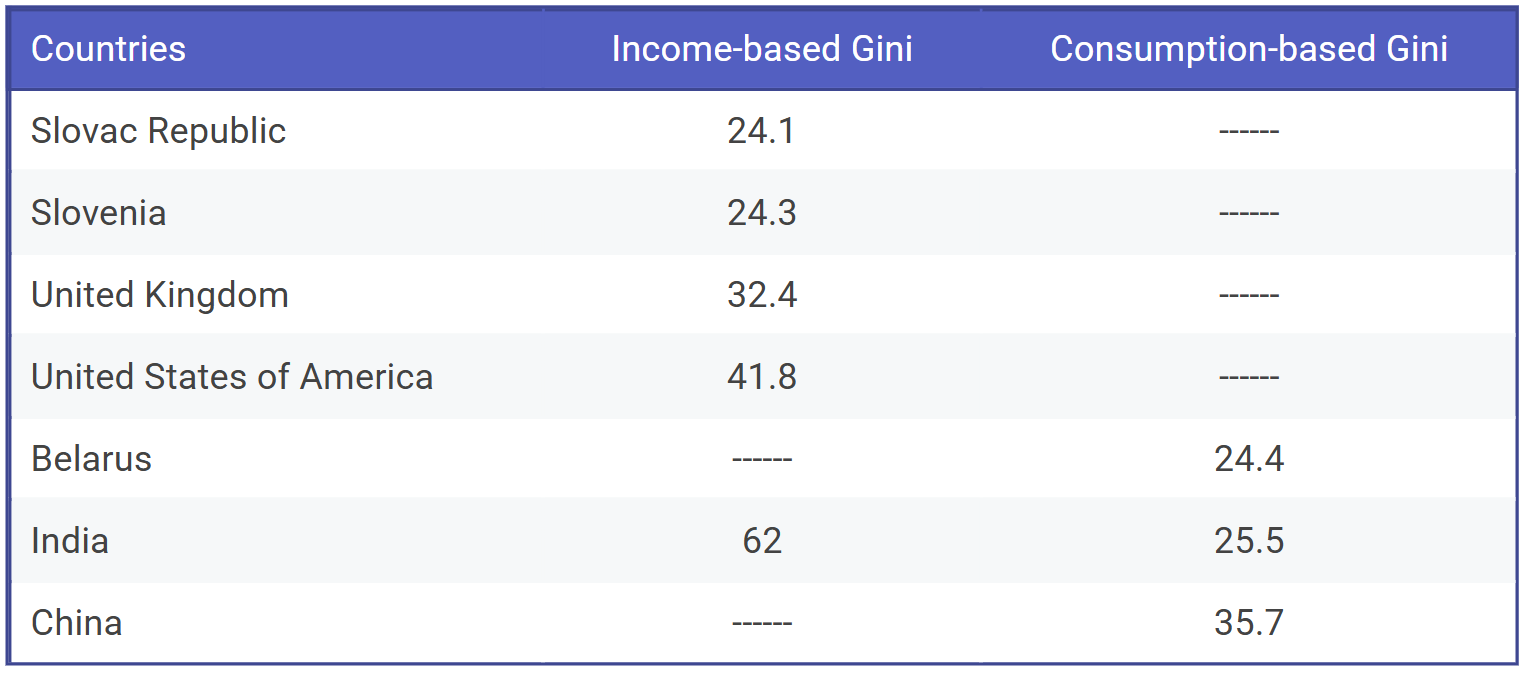
To put things in perspective, India’s income inequality has actually risen from 2004 to 2023. The World Bank brief clearly says this. Even the improvement in consumption inequality is very marginal—from 28.8 in 2011-12 to 25.5 in 2022-23. This is hardly celebratory; it rather shows that India’s consumption is facing strain.
Economist Surbhi Kesar, who was the first to point out PIB’s misrepresentation of World Bank data on X, writes that we might even be underestimating India’s consumption inequality due to data limitations. The 2022–23 Household Consumption Expenditure Survey introduced several changes in methodology compared to the earlier 2011–12 survey, making direct comparisons on poverty reduction unreliable.
Also, the Gini index is one inequality indicator, just like income and consumption are a few metrics to measure inequality. Like economist Santosh Mehrotra points out in The Wire, inequality manifests in various ways such as social inequality (owing to caste, ethnicity, class, etc) and wealth-based inequality (when wealth is concentrated in the hands of a few over the years and then passed down as inheritence), which are often beyond the scope of the Gini index but crucial for developing economies like India to take into account.
Importantly, these surveys and numbers do not highlight enough just how stark inequality is in India, in terms of wealth concentration. These issues have been widely flagged by economists and statisticians on several occasions.
(With inputs from Diti Pujara)
The post PIB’s claim that India is fourth most equal country citing World Bank data is misleading appeared first on Alt News.
This content originally appeared on Alt News and was authored by Shinjinee Majumder.
This post was originally published on Radio Free.
This content originally appeared on Democracy Now! and was authored by Democracy Now!.
This post was originally published on Radio Free.
From the prologue of the 40th anniversary edition of David Robie’s seminal book on the Rainbow Warrior’s last voyage, former New Zealand prime minister Helen Clark (1999-2008) writes about what the bombing on 10 July 1985 means today.
By Helen Clark
The bombing of the Rainbow Warrior in Auckland Harbour on 10 July 1985 and the death of a voyager on board, Greenpeace photographer Fernando Pereira, was both a tragic and a seminal moment in the long campaign for a nuclear-free Pacific.
It was so startling that many of us still remember where we were when the news came through. I was in Zimbabwe on my way to join the New Zealand delegation to the United Nations World Conference on Women in Nairobi. In Harare I met for the first time New Zealand Anglican priest Father Michael Lapsley who, in that same city in 1990, was severely disabled by a parcel bomb delivered by the intelligence service of the apartheid regime in South Africa. These two bombings, of the Rainbow Warrior and of Michael, have been sad reminders to me of the price so many have paid for their commitment to peace and justice.
It was also very poignant for me to meet Fernando’s daughter, Marelle, in Auckland in 2005. Her family suffered a loss which no family should have to bear. In August 1985, I was at the meeting of the Labour Party caucus when it was made known that the police had identified a woman in their custody as a French intelligence officer. Then in September, French prime minister Laurent Fabius confirmed that French secret agents had indeed sunk the Rainbow Warrior. The following year, a UN-mediated agreement saw the convicted agents leave New Zealand and a formal apology, a small amount of compensation, and undertakings on trade given by France — the latter after New Zealand perishable goods had been damaged in port in France.
Both 1985 and 1986 were momentous years for New Zealand’s assertion of its nuclear-free positioning which was seen as provocative by its nuclear-armed allies. On 4 February 1985, the United States was advised that its naval vessel, the Buchanan, could not enter a New Zealand port because it was nuclear weapons-capable and the US “neither confirm nor deny” policy meant that New Zealand could not establish whether it was nuclear weapons-armed or not.
In Manila in July 1986, a meeting between prime minister David Lange and US Secretary of State George Schultz confirmed that neither New Zealand nor the US were prepared to change their positions and that New Zealand’s engagement in ANZUS was at an end. Secretary Schultz famously said that “We part company as friends, but we part company as far as the alliance is concerned”.
Pour les 40 ans de l’attentat de la France contre le Rainbow Warrior, le journaliste néo-zélandais @DavidRobie publie une nouvelle édition de son livre sur le dernier voyage du navire de Greenpeace. Préfacée par Helen Clark, ex-PM de Nouvelle-Zélandehttps://t.co/n1v8Nduel6
— Edwy Plenel (@edwyplenel) July 10, 2025
New Zealand passed its Nuclear Free Zone, Disarmament and Arms Control Act in 1987. Since that time, until now, the country has on a largely bipartisan basis maintained its nuclear-free policy as a fundamental tenet of its independent foreign policy. But storm clouds are gathering.
Australia’s decision to enter a nuclear submarine purchase programme with the United States is one of those. There has been much speculation about a potential Pillar Two of the AUKUS agreement which would see others in the region become partners in the development of advanced weaponry. This is occurring in the context of rising tensions between the United States and China.
Many of us share the view that New Zealand should be a voice for deescalation, not for enthusiastic expansion of nuclear submarine fleets in the Pacific and the development of more lethal weaponry.

Nuclear war is an existential threat to humanity. Far from receding, the threat of use of nuclear weapons is ever present. The Doomsday Clock of the Bulletin of Atomic Scientists now sits at 89 seconds to midnight. It references the Ukraine theatre where the use of nuclear weapons has been floated by Russia. The arms control architecture for Europe is unravelling, leaving the continent much less secure. India and Pakistan both have nuclear arsenals. The Middle East is a tinder box with the failure of the Iran nuclear deal and with Israel widely believed to possess nuclear weapons. North Korea continues to develop its nuclear weapons capacity. An outright military conflict between China and the United States would be one between two nuclear powers with serious ramifications for East Asia, South-East Asia, the Pacific, and far beyond.
August 2025 marks the eightieth anniversary of the nuclear bombing of Hiroshima and Nagasaki. A survivors’ group, Nihon Hidankyo, was awarded the Nobel Peace Prize last year. They bear tragic witness to the horror of the use of nuclear weapons. The world must heed their voice now and at all times.
In the current global turbulence, New Zealand needs to reemphasise the principles and values which drove its nuclear-free legislation and its advocacy for a nuclear-free South Pacific and global nuclear disarmament. New Zealanders were clear — we did not want to be defended by nuclear weapons. We wanted our country to be a force for diplomacy and for dialogue, not for warmongering.
The multilateral system is now in crisis — across all its dimensions. The UN Security Council is paralysed by great power tensions. The United States is unlikely to pay its dues to the UN under the Trump presidency, and others are unlikely to fill the substantial gap which that leaves. Its humanitarian, development, health, human rights, political and peacekeeping, scientific and cultural arms all face fiscal crises.
This is the time for New Zealand to link with the many small and middle powers across regions who have a vision for a world characterised by solidarity and peace and which can rise to the occasion to combat the existential challenges it faces — including of nuclear weapons, climate change, and artificial intelligence. If our independent foreign policy is to mean anything in the mid-2020s, it must be based on concerted diplomacy for peace and sustainable development.
Movement back towards an out-of-date alliance, from which New Zealand disengaged four decades ago, and its current tentacles, offers no safe harbour — on the contrary, these destabilise the region within which we live and the wide trading relationships we have. May this new edition of David Robie’s Eyes of Fire remind us of our nuclear-free journey and its relevance as a lode star in these current challenging times.
This post was originally published on Asia Pacific Report.

Zohran Mamdani’s shocking victory in the Democratic primary for mayor of New York City was not just a win over former New York Gov. Andrew Cuomo, but also over a set of Islamophobic smear tactics that have become all too familiar — and will continue to dog him in the run-up to November.
In the days before the primary, Mamdani was asked repeatedly about the slogan “globalize the intifada” on the assumption that because he has spoken out against Israel’s ongoing genocide in Gaza, he should have to answer for the protest cry. He said that he had not used it himself, but he didn’t cede rhetorical territory to the political establishment by condemning the phrase. Rather than take the bait, Mamdani made clear that many take “globalize the intifada” as a call to demand Palestinian equal rights, and that he doesn’t see it as his role to police speech.
Mamdani, who grew up in New York City and was just shy of 10 years old on September 11, 2001, may well have heard in the question the same ominous soundtrack that has haunted Arab and Muslim people in the United States for decades — and reached a fever pitch after the 9/11 attacks. We have watched bad faith actors routinely demonize Arabic language and Islam day in and day out. Lost all too often is any grasp of what the language actually means.
As an Arabic speaker, I can delve into the linguistics. In Arabic, just as with its semitic sibling Hebrew, words are largely derived from three-letter roots. These three-letter roots then act as building blocks for a wide range of associated words, and they are modified into 10 different awzan, or patterns, to create transitive, causative, passive, and reflexive forms of the root.
The root n-f-d is the verb “to shake” or “to shake off.” Think of tapping the ashes off the end of a cigarette or shaking the dust out of an old rug. One of the awzan of the root that converts it into its passive form is iNtiFaDa, which means “a shaking off.” When this word is used to describe a singular historical occurrence, it means a popular uprising — in other words, a peoples’ shaking off of oppression.
This is not only the meaning of the word in a Palestinian context. Arabic language texts discussing various uprisings across history, and on any continent, would use the word intifada because that is simply what the word means.
This exercise feels at once obligatory and unnecessary. What is at issue here is not simply what the word means, but who gets to define its meaning and who gets to have their intentions and the validity of their concerns defined by others. This fundamental dynamic, which is an all-too-common theme in a post-9/11 America where Islamophobia and anti-Palestinian racism shape so much of our discourse, is precisely what Mamdani was refusing to play along with — and good on him for it.
Of course, intifada is but one example of this. Whether it is English-language phrases or slogans like “from the river to the sea, Palestine will be free,” or Arabic-language words or phrases that are constantly defined as suspicious or threatening, the words’ actual meanings and their speakers’ genuine intentions end up being far less important than how bad faith actors with larger platforms want them to be understood.
On a nightly basis after September 11, 2001, so-called terrorism experts who knew next to nothing about the language, religion, or cultures of the region would appear on news broadcasts — indoctrinating our friends, neighbors, classmates, and coworkers to treat our language as suspicious.
We watched as those subtle and innocent nuances of our tongue were twisted into indicators of suspicion.
I remember hearing an Arab-American elder once explain to a curious neighbor, “In Arabic, God is in every conversation.” At the time, I thought it was a bit overdramatic. It is undoubtedly true that it is hard to imagine an Arabic conversation where Allah is not uttered. Whether in our bismillahs, alhamdulillahs, mashallahs or inshallahs or our yallahs or wallahs, God makes routine appearances. But these are not necessarily religious conversations at all. Even the non-religious use these terms; it is just the nature of how we communicate in our language due to its historic ties to faith. It is also one of the many things that makes the Arabic language beautiful.
And yet we watched as those subtle, innocent, beautiful nuances of our tongue were twisted into indicators of suspicion. In an American discourse so heavily imbued with anti-Palestinian racism and so rife with Islamophobia, Palestinians or those who dare see them as human are not allowed to have legitimate intentions or legitimate grievances. They are to be constantly seen as suspicious. Even if they speak of human rights, equality, dignity, they can never really be trusted to mean those things because of who they are — sneaky shapeshifters with deeply held, murderous, ulterior motives. It is quite remarkable how much this echoes antisemitism throughout history, and that should surprise no one. All forms of racism are connected.
Imagine for a minute subjecting words or phrases in a different language, or about a different people, to the same unfair treatment. Consider the Hebrew phrase Am Yisrael Chai. The literal meaning of the phrase is “the people of Israel live,” and there are plenty of instances where the use of this phrase is mundane. However, the phrase is routinely chanted by murderous Israeli settlers as they engage in mob violence against Palestinians living under Israeli occupation. Recently, it has been shouted by Israeli soldiers as they commit heinous war crimes in Gaza and shared widely and proudly by those same soldiers on social media. Thus, one could argue that Am Yisrael Chai is a genocidal slogan and must be banned, and that all those who use it or have used it must be criminalized and viewed with deep suspicion.
Surely, this is absurd. And yet this is the absurdity Palestinians and those who support their freedom are constantly subjected to. Still, too many cannot see the glaring double standard.
In her raving Islamophobic diatribe against Mamdani, for which she has since sort of apologized, Sen. Kirsten Gillibrand of New York accused Mamdani of calling for “global jihad.” This is, of course, not something Mamdani ever did, but accuracy has never been the hallmark of these sorts of smears.
Gillibrand is not alone in this, but representative of a political class where the erasure of Palestinian security is normalized.
More revealing, though, were other parts of Gillibrand’s comments. Referring to “globalize the intifada” she said, “It doesn’t matter what meaning you have in your brain, it is now how the word is received. When you use a word like intifada, to many Jewish Americans and Jewish New Yorkers, that means you are permissive for violence against Jews.” She went on to explain that if you “talk to our LGBT community, you talk to our Black community, you talk to our Hispanic community, there are words and there are imagery and there are things that are said that they will hear and feel it as a dagger to their throat.”
Here Gillibrand shows she is capable of thinking about how words are received by other communities. But her choice of examples leaves one wondering: Has she ever thought about how people in the Palestinian, Arab, and Muslim communities receive certain words or imagery? How does Gillibrand think these communities hear her Islamophobia? How does she think we receive the ritual regurgitation of phrases like “Israel has a right to exist as a Jewish state” — which, to Palestinians, means that Israel has a right to ethnically cleanse us and deny us rights and equality.
How our communities receive things doesn’t seem to matter much to Gillibrand, and it is probably easier to just pretend we do not exist — especially when the top contributor to her campaign in the last five years was the American Israel Public Affairs Committee, which gave her nearly half a million dollars between 2019 and 2024. Gillibrand is of course not alone in this, but rather representative of a political class where the erasure of Palestinian concerns and security is entirely normalized. Not all throats are created equal.
It feels as if Mamdani’s election victory is a turning point away from the dominance of that very political class. He could have played the game exactly as they did. Condemn the phrase and those who say it, just as Gillibrand and others would have wanted him to. He would have been wrong to do so if he did. Not only would it reinforce the very policing of Palestine-related speech that is at an all-time high at this moment, but it also wouldn’t have helped him politically at all.
There is nothing Mamdani can say that would silence the bad faith actors losing their minds over a Muslim millennial socialist’s obvious edge in the New York City mayoral race. Most of them are purely interested in trying to maintain a quickly evaporating pro-Israel consensus. If Mamdani condemned the phrase, they would say he is being deceptive and demand he condemn something else, forcing him to choose between perpetually being on the defensive or perpetually appearing to equivocate.
Perhaps worse, he’d be selling out the very voters who made the foundation of his campaign. This is not to say that most Mamdani voters use the phrase “globalize the intifada.” I’d bet many had never heard it before the last few weeks. But I do think they are capable of identifying bad faith smears aimed at taking down candidates that challenge the establishment. That’s why the smears aimed at Mamdani didn’t just fail, they backfired.
Mamdani’s campaign represented several things at the same time: a break from the cynicism that has dominated our politics, a political underdog aiming at the very centers of power, and a youthful turn away from the politics of an older generation of leaders. To condemn the phrase would signal a betrayal of the principles his campaign represented.
But Mamdani isn’t just standing up for what he believes in; he is also reading the political winds correctly. The Democratic electorate today looks very different on the issue of Palestine than it did back in 2009, when Gillibrand was first elected to the Senate. CNN’s Harry Enten summed up the sea change recently as he discussed polling data on views toward Israelis and Palestinians. Democrats overwhelmingly sympathize with Palestinians over Israelis today. Some of us have been identifying this shift for years, but it is more pronounced today than ever before, and there is likely more to come.
The Israeli government’s rightward shift and the exposure of its constant abuses against Palestinians have driven this turn for years. But the last 21 months of Israel’s genocide in Gaza are unlike anything we have ever seen. If the 1967 war implanted the image of Israel as the underdog against the Arab Goliath in the American mind, Israel now as the genocidal criminal in Gaza will be one of the defining ideas for an entire generation of Americans and will shape their views about Israel for decades to come. And Americans are not merely tired of seeing the horrors the Israeli military is inflicting on the civilians of Gaza — they are also increasingly tired of being told they are antisemitic for speaking up about it.
As public opinion shifts, efforts to maintain a pro-Israel U.S. policy will increasingly involve repression and policing that will only seem more ridiculous and desperate over time. Voters who have shifted significantly on Israel will angrily wonder why their elected representatives echo pro-Israel lobby groups more than their own constituents. In short, Mamdani’s politics will be seen as more welcomed and more authentic among Democratic voters than those of the Gillibrands or Cuomos of the world.
It’s about time that more politicians took a note from Mamdani: Stop taking the bait.
The post Zohran Mamdani Shows Democrats How Not to Take the Bait appeared first on The Intercept.
This post was originally published on The Intercept.
This content originally appeared on Radio Free Europe/Radio Liberty and was authored by Radio Free Europe/Radio Liberty.
This post was originally published on Radio Free.
The private prison industry saw its influence wane under Joe Biden, but it remains dominant in the business of immigration detention. So when President Donald Trump signed the so-called “Big, Beautiful Bill” on July 4, dedicating $45 billion to immigration detention with a goal to double or triple the population behind bars, it was a huge payoff.
The victory was in the works for years. A private prison company handed consulting and lobbying gigs to Trump’s allies, its political action committee was the first to max out its donation to Trump, and industry executives had already made plans to reopen shuttered prisons — laying the groundwork for what they promised investors would be an incarceration bonanza.
In the 2024 election cycle, employees and PACs affiliated with the publicly traded industry behemoths GEO Group and CoreCivic contributed overwhelmingly to Republicans and Trump.
Republicans received 92 percent of $3.7 million in contributions affiliated with GEO Group and 96 percent of the $785,000 in contributions affiliated with CoreCivic, according to OpenSecrets, a nonpartisan, nonprofit research group that tracks official disclosures. When Trump won, the two companies gave $500,000 each to his inaugural committee.
“The private prison corporations were keenly aware of the implications of the then-Trump campaign’s platform for mass deportations.”
Even though the industry kept profiting from the Biden administration — despite a supposed ban on private prisons — one advocate said it was clear to her why companies went all-in on Trump.
“The private prison corporations were keenly aware of the implications of the then-Trump campaign’s platform for mass deportations,” said Eunice Hyunhye Cho, a senior staff attorney at the American Civil Liberties Union’s National Prison Project. “There is no doubt that these private prison companies were keenly aware of the potential profits to be made under such a scheme.”
Before the federal budget bill passed, private prison executives on earnings calls with investors were exultant about their upcoming business opportunities under the law — and held regular meetings with the Trump administration to pitch new plans on how to lock people up.
Now, the White House hopes to get the bill’s funding out the door quickly, in order to expand the middle part of a deportation pipeline that stretches from arrests at Home Depots to flights abroad.
In a statement, the White House rejected the idea that the budget bill or any of Trump’s immigration policies were shaped by industry.
“The only people who influence the President’s decision-making are the American people. But leave it to the Fake News Intercept to pathetically and desperately try to attack agenda that the American people voted for – deportations of criminal illegal aliens,” Abigail Jackson, an administration spokesperson, wrote in an email.
Days after his inauguration in 2021, Biden made a splash by announcing that the federal Bureau of Prisons, or BOP, would no longer house incarcerated people in private prisons.
The supposed ban only affected a few thousand of the BOP’s roughly 150,000-person population, and the private prison companies soon managed to find workarounds.
More importantly, Biden’s order did not touch the much larger number of people held in immigration detention, which is reserved mostly for people accused of committing civil violations such as illegal presence in the U.S.
Three years into Biden’s administration, about 90 percent of people in immigration detention were housed in private facilities. There were about 40,000 people in immigration detention by the end of his term.
Many were detained in facilities owned or operated by CoreCivic and GEO Group. Both companies also have subsidiaries profiting off other parts of the immigration system, ranging from an electronic monitoring company GEO Group bought in 2010 to a transportation company owned by CoreCivic.
Although they continued doing business with the Biden administration, private prison companies bristled at his at his attitude toward the industry.
In addition to the millions in campaign cash the private prison industry funneled to Trump and Republicans, there were jobs for major figures in Trump’s orbit. Tom Homan, the former acting director of U.S. Immigration and Customs Enforcement, had a consulting gig with GEO Group that was only made public this year. Pam Bondi, the former Florida attorney general, picked up work as a lobbyist for the company in 2019, shortly before she joined Trump’s defense team at his first impeachment. Trump in his second term tapped Homan to serve as “border czar” and Bondi as U.S. attorney general.
While many industries with government work try to cozy up to former officials, Lauren-Brooke Eisen, the senior director of the Brennan Center’s Justice Program and author of a book on the industry, said private prisons cultivated unusually close relationships.
“There’s sort of always a revolving door between the private sector and the government, but what we’re seeing here is, we’re also seeing people with super close ties,” she said.
In a statement, GEO Group did not directly address questions about the donations to the Trump campaign or its ties to high-ranking administration officials.
“We are proud of the role our company has played for 40 years to support the law enforcement mission of U.S. Immigration and Customs Enforcement,” a company spokesperson wrote. “Over the last four decades, our innovative support service solutions have helped the federal government implement the policies of seven different Presidential Administrations.”
CoreCivic, meanwhile, said that it welcomed “the opportunity to support any political leaders who are open to the solutions our company provides to serious national challenges, including providing safe, humane care for people going through the civil immigration process and helping those in our criminal justice system prepare to return to our communities with the skills they need to be successful.”
The donation to the inaugural committee, CoreCivic spokesperson Ryan Gustin said, “is consistent with our past practice of civic participation in and support for the inauguration process, including contributions to inauguration activities for both Democrats and Republicans.”
The White House rejected out of hand the idea that campaign contributions, or the work that top officials conducted for the industry while out of office, had anything to do with crafting the specifics of the budget bill.
“The One, Big, Beautiful bill provides the funding necessary to fulfill the President’s promise to carry out the largest mass deportation operation in history. CoreCivic and GEO Group have received contracts under both Democrat and Republican administrations,” Jackson wrote.
After Trump’s first term, Homan hung up a shingle for a consulting firm that told prospective clients it had a “track record of opening doors,” resulting in big state and federal contracts.
As border czar, Homan has said he will not be involved in making decisions about individual contracts. Bondi has promised to consult ethics officials if any conflicts of interest come up, and a Justice Department spokesperson said she “played no role in the provisions for additional funding for immigration detention.”
Such denials do not sway Cho, the ACLU lawyer whose work includes representing people in immigration detention.
“Whatever those responses are doesn’t belie the fact that these companies clearly are purchasing influence in order to benefit politically and financially,” she said.
Citing reporting from The Intercept, Sen. Dick Durbin, D-Ill., in May called on Bondi to recuse herself from “any and all” activities tied to immigration detention that could directly or indirectly benefit GEO Group.
The administration has brushed off such critiques as it pushes ahead with its mass deportation plans. The Department of Homeland Security, which oversees ICE, says the budget law will allow it to secure 80,000 new detention beds and bring its total population over 100,000.
GEO Group said in November that Trump’s plans could help it fill 18,000 empty beds, translating into $400 million in additional annual revenue. CoreCivic said in February that it had pitched the federal government on plans for housing an extra 28,000 people.
The companies will face competition from states like Florida, which is relying on federal reimbursements to build tent camps at places such as the so-called “Alligator Alcatraz” facility in the Everglades intended to house 3,000 people.
“The $45 billion represents such an unprecedented broadening for federal prison funding for immigration.”
Cho said she does not think such state facilities pose a business threat to the private prison companies, in large part because there is so much money to go around.
“Even state detention systems often depend on private prison companies for operation,” she said. “The $45 billion represents such an unprecedented broadening for federal prison funding for immigration.”
In recent weeks, the major private prison companies have continued to make announcements about their growing capacity – for detention and profit. CoreCivic announced last month that it had spent $67 million on a detention center in Virginia that it expects to produce an extra $40 million in annual revenue.
If Homan has his way, many of the new detention centers springing up to fill the administration’s demand will be under looser state regulations instead of more stringent federal standards.
“It is really scary that we are seeing a reduction of oversight, along with this idea that we should loosen the standards, with this huge increase in funding.”
Stories of suffering behind bars are already proliferating as the detention population grows. Eisen noted that one of the Trump administration’s first actions at the DHS was to decimate an oversight office meant to investigate allegations of wrongdoing.
“It is really scary that we are seeing a reduction of oversight, along with this idea that we should loosen the standards, with this huge increase in funding,” she said.
The post The Private Prison Industry Looks Forward to Soaring Profits Thanks to Trump’s Budget appeared first on The Intercept.
This post was originally published on The Intercept.
In Louisiana, natural gas — a planet-heating fossil fuel — is now, by law, considered “green energy” that can compete with solar and wind energy projects for clean energy funding. The law, signed by Republican Governor Jeff Landry last month, comes on the heels of similar bills passed in Ohio, Tennessee, and Indiana. What the bills have in common — besides an “updated definition” of a fossil fuel as a clean energy source — is language seemingly plucked straight from a right-wing think tank backed by oil and gas billionaire and activist Charles Koch.
Louisiana’s law was based on a template created by the American Legislative Exchange Council, or ALEC, a conservative organization that brings legislators and corporate lobbyists together to draft bills “dedicated to the principles of limited government, free markets and federalism.” The law maintains that Louisiana, in order to minimize its reliance on “foreign adversary nations” for energy, must ensure that natural gas and nuclear power are eligible for “all state programs that fund ‘green energy’ or ‘clean energy’ initiatives.”
But natural gas, also known as methane gas, is no more “natural” than any other fossil fuel. Its primary ingredient is methane, an intense heat-trapping gas that is far more potent than the carbon pollution produced by coal and oil, though it doesn’t stay in the atmosphere as long. It’s often marketed as a “bridge fuel” — a less harmful fossil fuel that can be used as communities transition away from coal — but studies have found that over the long term, the planet-warming impact of the natural gas industry may be equivalent to that of coal. That’s because gas pipelines often leak; according to an Environmental Defense Fund analysis, natural gas pipelines in the U.S. allow between 1.2 million and 2.6 million tons of methane to escape into the atmosphere each year.
Louisiana State Representative Jacob Landry first introduced a near-identical bill to the model posted on ALEC’s website and to the other bills that have passed in Ohio, Tennessee, and Indiana. (The Washington Post reported in 2023 that ALEC was involved in Ohio’s bill; ALEC denies involvement.) Landry, who represents a small district in the southern part of the state, is the recipient of significant fossil-fuel-industry funding — and co-owns two oil and gas consulting firms himself. During his campaign for the state Legislature, Landry received donations from at least 15 fossil-fuel-affiliated companies and PACs, including Exxon Mobil (which has also funded ALEC) and Phillips 66. Those donations alone totaled over $20,000.
Representative Landry did not respond to multiple requests for comment. ALEC did not get back to Grist in time for publication.
While Louisiana has one of the least reliable grids in the country, that lack of reliability is in large part due to the state’s reliance on natural gas, which provides most of its electricity, according to a 2025 report from the Louisiana Legislative Auditor’s Office.
“Best practices have found that gas plants are susceptible to large-scale failures during extreme weather,” the auditors wrote. “Diversifying the energy sources used for electricity generation is a priority.”
Bills that benefit both the fossil fuel industry and the individual lawmakers who introduce them aren’t exactly a new genre in Louisiana, said Laura Peterson, a senior analyst with the Union of Concerned Scientists. What’s less standard is that this one is dressed up in climate-friendly language.
“Louisiana is a classic example of a captured state,” Peterson said. “Their state economy is just so dependent on fossil fuels and petrochemicals.” (The amount of money the fossil fuel industry brings to Louisiana’s people, though, has been on the decline since the turn of the century.)
The state accounts for about 10 percent of the country’s natural gas production and holds about 6 percent of U.S. natural gas reserves. Natural gas is already used to generate about three-quarters of the state’s electricity, and building out more pipeline projects to carry liquefied natural gas, or LNG, won’t necessarily make electricity bills cheaper for residents, Peterson said.
“Building LNG infrastructure is not going to lower anyone’s energy prices in the short term,” since it takes many years to build a pipeline, Peterson said. “And there’s a lot of research that shows that overreliance on gas leaves power grids vulnerable to extreme weather, which Louisiana has a lot of.”
Jeffrey Clark, president of the Louisiana Advanced Power Alliance — an industry group representing both renewable and fossil fuel energy companies and investors — testified in opposition to the bill in early June.
“This legislation is being promoted as a solution to Louisiana’s reliability challenges. But with all due respect, it is a solution in search of a problem,” Clark said. “We support fossil fuels as a key part of the nation’s energy mix, but codifying them as the only acceptable path forward dismisses a growing body of evidence that grid reliability depends on resource diversity.”
Fossil fuel advocacy groups lauded the move. Larry Behrens of the nonprofit Power the Future wrote that the legislation turns Louisiana into an “energy sanctuary state,” taking “a direct shot at the China-backed solar and wind lobby.”
Reclassifying natural gas as “green” energy means that proposed natural gas pipelines may be able to access funding that would otherwise have gone to new solar or wind projects; it may also make natural gas companies more appealing to environmentally conscious investors. ALEC, the right-wing think tank that provided the template language for Landry’s bill, noted in a press release that resolutions like this could pave the way for more AI data centers in the state, too. “Redefining ‘green energy’ allows utilities to continue using natural gas while fulfilling state ‘green energy’ or ‘clean energy’ initiatives,” ALEC staffer Mark Lucas wrote.
Over the years, ALEC has succeeded in getting laws that benefit fossil fuel companies passed across the country. Recently the group, which was founded in the 1970s, has helped draft legislation criminalizing grassroots protest against pipelines, gas terminals, and other fossil fuel infrastructure — versions of that bill had passed in 17 states by 2022. They have also drafted bills aiming to punish economic boycotts of the oil industry. And there are currently 114 different model policies related to energy on their website, 23 of which specifically address “green energy.”
“It’s classic greenwashing, right?” said Peterson of the new Louisiana law — using the language of sustainability to describe an activity that’s actually not sustainable at all. “The intent of these laws is to allow the buildout of fossil fuel infrastructure, which will perpetuate the use of fossil fuels for decades to come.”
This story was originally published by Grist with the headline Louisiana is the latest state to greenwash gas on Jul 10, 2025.
This post was originally published on Grist.
Well, I wrote this below a while back, and I am updating it here:

If anything you do brave liberators of Gaza, just find these people and immolate them many on my Substack tell me: “Court said to approve mom’s request to use fallen soldier son’s sperm to have grandchild.
Sharon Eisenkot permitted to use sperm of 19-year-old son Maor, Golani fighter killed in Gaza who was also nephew of ex-IDF chief Gadi Eisenkot.
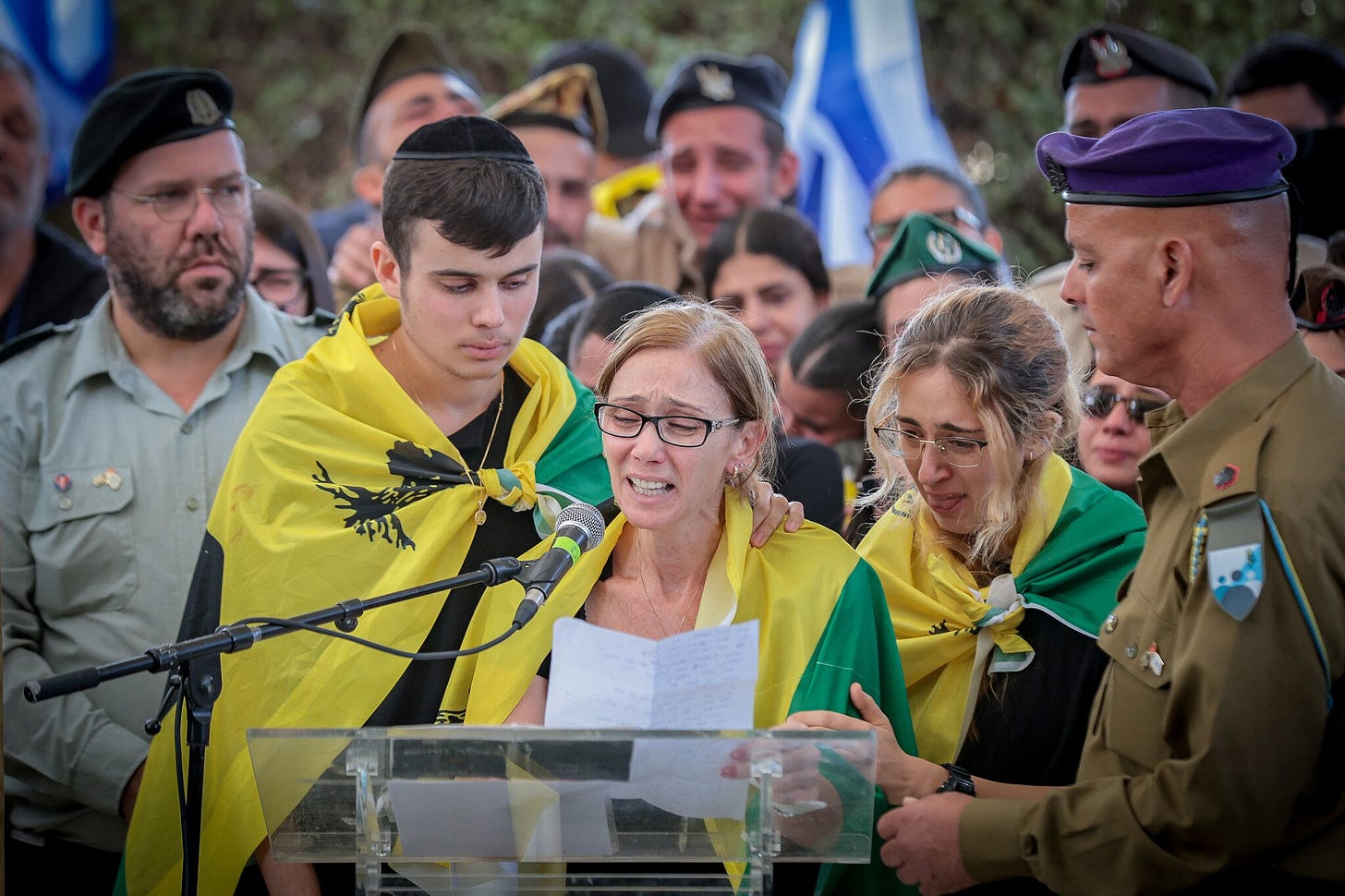
This is what domination looks like. This is what schizophrenia looks like. This is what white supremacy looks like. While what, 100 a day murdered and imploded by Israel, those non-humans they call rats and roaches and snakes — Gazans.
[War cabinet minister and former IDF chief of staff Gadi Eisenkot, with family and friends, at the funeral of his son Gal, in Herzliya on December 8, 2023.]

So, there are many levels of leeching and leeches: This is not an in-your-face CRIME?

THOUSANDS OF FAMILIES CUT OFF FROM WATER: A municipality spokesman has told Al Jazeera that thousands of families in eastern Gaza City have been without water for about a week. Asem al-Nabi said the water blockade means Palestinians there are now suffering from a state of dehydration that cannot be addressed without external intervention.
Here, my Substack Headlines in the News Feed of Haeder rant: Now Mothers of IOF Want Sons’ Sperm for more Evil Offspring
Continuing the DV piece =+
Leeches.

Several times, the question arose of whether Menachem Begin saw any comparison between the struggle of the Palestinians and the Jews’ War of Independence.
Once, Mike Wallace, the well-known American interviewer asked him directly,
“Mr. Prime Minister, you were the commander of a terrorist organization. Do you see any comparison between this and the PLO?”

Begin replied,
“There’s nothing at all to compare. We fought to liberate our land from a foreign regime, from the British. They want to wipe us off the face of the Earth and take our land from us, because this land is ours. We threw out the British because the land is ours. What do the Arabs want? To throw us out of our land! There’s no comparison between the PLO, or any group of murderers of theirs. Another issue is the method of battle. They kill every man, woman, and child, whereas we did everything to avoid harming civilians. True, sometimes disasters happened, and civilians were hurt, but this was not part of our battle tactics.”

So, is it Zionism or Jewish Zionism or Israeli Judaism that is the global pandemic, the virus, or the parasite? Asking the questions and proposing the answers are all part of that super duper thought experiment, nothing to do with antisemitism.
Read: Traumatic insemination, also known as hypodermic insemination, is the mating practice in some species of invertebrates in which the male pierces the female’s abdomen with his aedeagus and injects his sperm through the wound into her abdominal cavity (hemocoel).[1] The sperm diffuses through the female’s hemolymph, reaching the ovaries and resulting in fertilization.
The process is detrimental to the female’s health. It creates an open wound which impairs the female until it heals, and is susceptible to infection. The injection of sperm and ejaculatory fluids into the hemocoel can also trigger an immune reaction in the female. Bed bugs, which reproduce solely by traumatic insemination, have evolved a pair of sperm-receptacles, known as the spermalege. It has been suggested that the spermalege reduces the direct damage to the female bed bug during traumatic insemination. However experiments found no conclusive evidence for that hypothesis; as of 2003, the preferred explanation for that organ is hygienic protection against bacteria.[2]
The evolutionary origins of traumatic insemination are disputed. Although it evolved independently in many invertebrate species, traumatic insemination is most highly adapted and thoroughly studied in bed bugs, particularly Cimex lectularius.[1][3] Traumatic insemination is not limited to male-female couplings, or even couplings of the same species. Both homosexual and inter-species traumatic inseminations have been observed.
*****

Capitalism: A Rape Story! Qatar?
Turns out that Israel isn’t the only foreign power that commands tremendous influence over the United States thanks to lobbying (via AIPAC).
Enter Qatar.
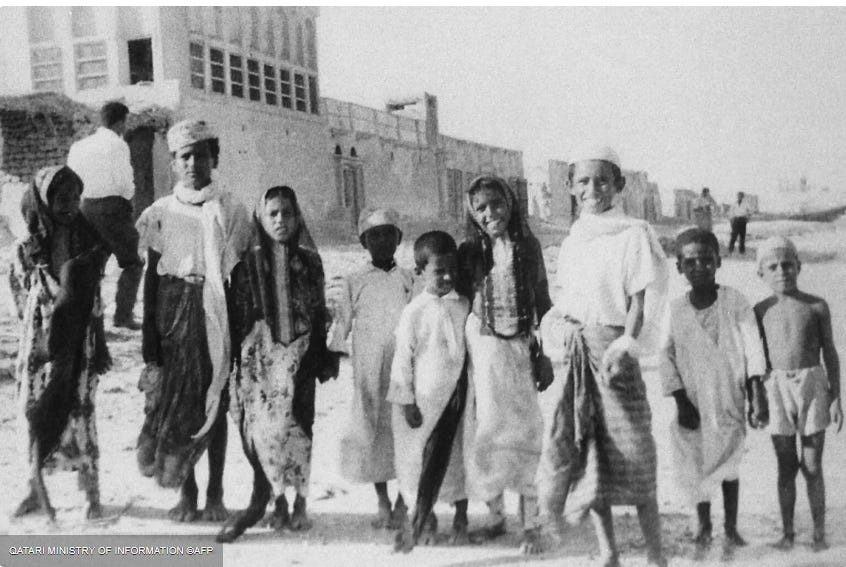
Devolution:

And now? That bed bug, or beetle:

Trump and Israel, or, the male beetle and the male bed bug … the female seed beetle (or bean weevil; Callosobruchus maculatus) has to contend with her partner’s nightmarish penis – an organ covered in hard, sharp spikes. Just see if you can look at the picture on the right without wincing.
It’s no surprise then that females sustain heavy injuries during sex. But why have male beetles evolved such hellish genitals? What benefits do they gain by physically harming their partners?
It’s possible that the injuries directly benefit the males, either because they stop the females from mating again or spend more efforts in raising their fertilised eggs to avoid the strain of future liaisons.

Below — a variation on the theme of traumatic copulation, beetle and bed bug, both blood suckers.

We need Che, man, a few tens of millions of Ches:
Ten Years ago, this Source: Middle East Monitor
Che Guevara’s visit to Gaza in 1959 was the first sign of transforming the Zionist colonization of Palestine from a regional conflict to a global struggle against colonialism. The trigger was the Bandung conference in 1955 and the resulting Non-Aligned Movement, whose members has just recently shaken the yoke of foreign domination. The stature of Nasser, as a world leader in the struggle against Imperialism and colonialism, brought world leaders to see for themselves the devastating results of the ethnic cleansing of Palestine, clearly demonstrated in Gaza refugee camps.
Gaza Strip became the symbol of Palestine. This tiny sliver of land (1.3% of Palestine) remained the only place raising the flag of Palestine. It carried a major part of al Nakba burden when it became the temporary shelter for the inhabitant of 247 villages, expelled from their homes in southern Palestine. Villages in the south were ethnically cleansed by the Israeli military operation “Yoav”, also termed “The Ten Plagues”, in October 1948. Not a single Palestinian village remained. This act of total ethnic cleansing was propelled by several massacres which took place in Al Dawayima, Bayt Daras, Isdud, Burayr, among others.
Refugees, now corralled into Gaza Strip, were not immune from Israeli attacks even after their expulsion. The Majdal hospital was bombed in November 1948, as was the nearby al Joura village, which stood on the site of ancient Ashkelon and from which many future Hamas leaders would emerge. In January 1949, Israelis bombed food distribution centers in Dayr Al Balah and Khan Younis at peak hours, leaving over 200 bodies decimated by air raids. These raids led the usually restrained Red Cross to describe it as a “scene of horror”.
The occupation of Palestinian land and the expulsion of its population gave rise to a resistance movement, known then as the fedayeen. These resistance fighters crossed the Armistice line to attack the occupiers of their land.
In order to stop the incursions of the fedayeen and eliminate the idea of resistance, Israel continuously attacked the Gaza Strip refugee camps. In August 1953, Unit 101, led by Ariel Sharon, attacked Bureij refugee camp and killed 43 people in their beds. In August 1955, Israel, again led by Ariel Sharon, blew up the Khan Younis police station killing 74 policemen. In the same year, the Israelis killed 37 Egyptian soldiers in Gaza railway station and 28 others who were on their way to defend the others. The last attack changed the course of history in the region.
Egyptian president Gamal Abdel-Nasser, who assumed power in Egypt in July 1952, signed the first armaments deal with the Soviet Block for arms denied to him by the British. He also authorised the fedayeen resistance by officially organising them under Colonel Mustafa Hafez.
On 29 October 1956 Israel invaded Sinai in collusion with Britain and France. The attacking Israeli soldiers entered Khan Younis on 3 November 1956, and collected all males between the ages of 15 and 50 from their homes and shot them in cold blood at their doorstep or against a wall in the town’s main square. The names of the 520 people killed have been listed. The following week, another massacre of refugees took place in Rafah. There were a deafening silence in the West about these massacres until the gifted cartoonist Joe Sacco immortalised them in his book Footnotes in Gaza.
These tragic events came to the world’s attention when Nasser became one of the recognised leaders of the Non-Aligned Movement starting with Bandung conference in 1955. Gaza Strip and Palestine came globally to light as the latest case of colonialism and ethnic cleansing.
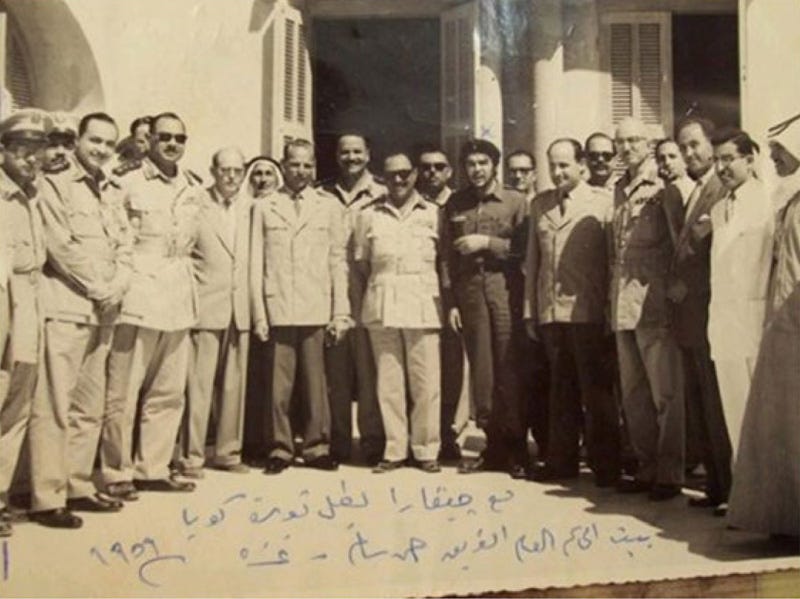
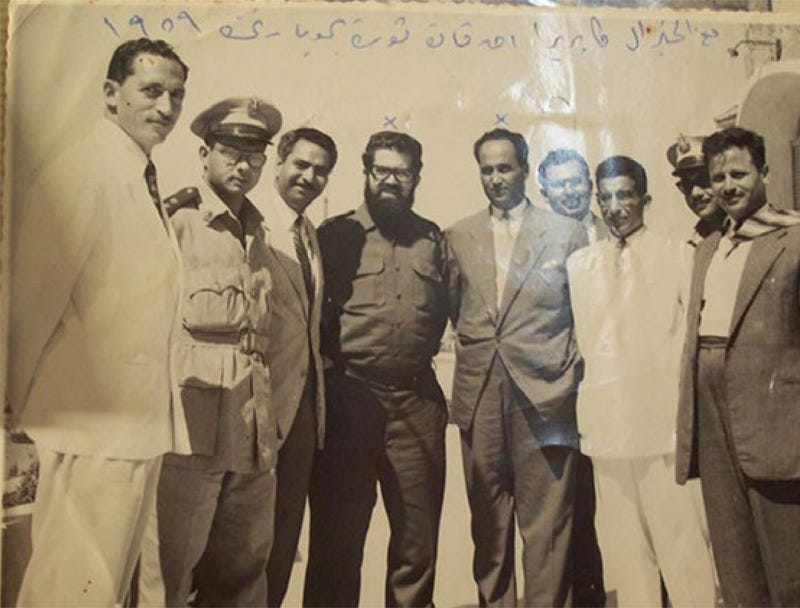
As a result of this political development, Che Guevara, the Latin American revolutionary, came to visit Gaza Strip at Nasser’s invitation.
Guevara’s visit was momentous. It was the first time that a famous revolutionary comes to see the devastation created by Al Nakba first hand. He was met most enthusiastically by resistance leaders, such as Abdullah Abu Sitta, leader of the fedayeen (and leader of the southern front in the Arab Revolt of 1936, seen in [Fig-1], to the extreme right in Arab dress) and Qassem el Farra, third from right, Secretary of Khan Younis Municipality who kept records of fedayeen and their activities. Both were members of Palestine Legislative Council.
According to evidence I received from contemporaries about the visit, Guevara told Palestinian refugees they must continue the struggle to liberate their land. There was no way but resistance to occupation, he said. He admitted that their case was “complex” because the new Jewish settlers occupied their homes. “The right must eventually be restored”, he affirmed. He offered to supply arms and training but Castro wanted this aid to be coordinated through Nasser.
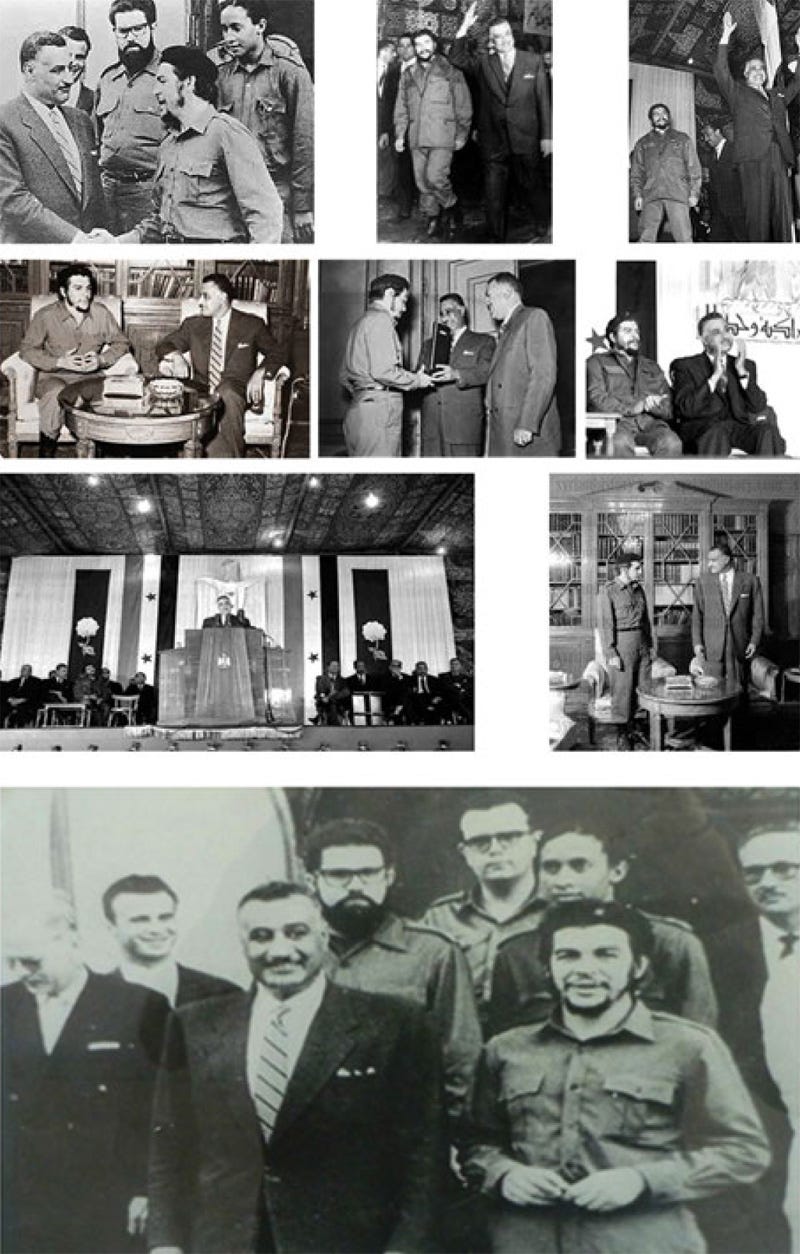
Mustafa Abu Middain, Al Bureij camp leader, took Guevara to visit the camp and showed him cases of poverty and hardship. “We have worse case of poverty”, Guevara shot back. “You should show me what you have done to liberate your country. Where are the training camps? Where are the factories to manufacture arms? Where are people’s mobilisation centres?”

Guevara was accompanied by General Caprera, an expert in Guerilla warfare. Caprera [Fig-2, with the beard] met with community leaders to advise on methods of resistance. Guevara became the icon of Palestinian resistance and struggle for freedom.[Fig-3]
Nasser took great interest in Guevara’s visit. He met him in his office, took him to public and official functions, introduced him to community leaders and presented him with medals [Fig-4, composite photo]. That was the start of very close relationship of revolutionary Latin America with Nasser and the Palestinians till this day.
After the visit, Cuba gave scholarships to Palestinian students, granted citizenships for stranded Palestinians and held many conferences in support of Palestine.
During the Israeli war on Gaza in the summer of 2014 Cuba sent tons of humanitarian aid to Gaza and received the injured. The support spread to most Latin American countries. El Salvador, Chile, Ecuador, Peru and Brazil have all withdrawn their ambassadors from Israel in protest. Bolivia’s President Evo Morales labeled Israel a “terrorist state” and restricted the entry of Israelis into the country. President Nicolás Maduro of Venezuela “vigorously condemned the actions of the illegal state of Israel against the heroic Palestinian people”. Nicaragua Solidarity Campaign with Palestine was very vocal both in the official and popular fields. The presidents of Uruguay, Brazil, Argentina and Venezuela issued a joint statement calling for a cessation of violence and an end to the Israeli blockade of Gaza Strip.
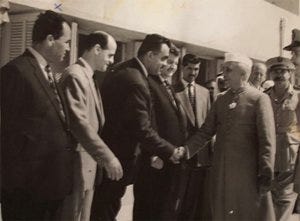
In the 1950s, Guevara was not the only well known personality of the Non-Aligned Movement to endorse the rights of Palestinians in a free Palestine. Jawaharlal Nehru, Prime Minister of India, also, came to visit Gaza in the same period [Fig-5]. That was the start of close Indian and other Asian support for Palestine.
Today Palestine is the symbol of the struggle of liberation from the last and longest colonial project. That is why over three quarters of the world countries support Palestine in the United Nations. Those few who did not are the remnants of the old colonial Western countries which created the colonial project in Palestine in the first place.
*****

Hero on the right, above, and alas, the golden shower (probably) young girls on the lap and in the bedroom (certainly) Epstein/Mossad/Bibi Honey Pot/Trap Tapes on the left, the Apprentice, Rapist in Chief.
Here’s Dennis Kucinich, back to recovering some of his senses after working for RFK Jr to head to the White Man’s House:
But, he still takes that dirty regime’s ploy, using a lion (hader) as their touchstone for murdering Iranians, when nothing about Israeli Jews is like a LION:

Dennis: Israel’s government, which has undertaken, with prevaricative impunity the illegal occupation and theft of Palestinian water sources, farmland, homes, property, and energy resources through ethnic cleansing and the execrable crimes of mass starvation and genocide in Gaza, has further escalated a world crisis by the preemptive bombing attack on Iran, through a self-proclaimed “Operation Rising Lion.”
This deadly deceit is of monumental proportions that one must struggle with the horrific reality it presents.
Attempting to label such crimes as a defensive strikes does violence to reason. The historical record will show that Israel’s oft-repeated insistence on the Iranian nuclear weapon threat was a contrivance to justify an arms buildup funded almost entirely by the American taxpayer.
America’s so-called defense of Israel’s freedom has been turned into a protection racket of such dimensions as to make the mafia blush. That racket has its own devises. Democratic and Republican Administrations, alike, have been contemplating an attack on Iran for decades. President Trump’s assurances of avoiding war while working closely with Netanyahu damages the President’s credibility, either he was not telling the truth or he was misled by people in his own foreign policy establishment.
Israel’s government now defines freedom thusly: Freedom to commit genocide, freedom to starve a defenseless population, freedom to wage aggressive war, and freedom to posture and to lie about all of their inhuman actions before the entire world and to demand everyone agree or be smeared as “anti-semites.”
*****

This guy sells dildos with his daughter. Look up those videos, man: Rabbi Shmuley Boteach today met with Democratic Presidential candidate Robert Kennedy, Jr. and discussed Israel, the rise of antisemitism, and Kennedy’s recent tweet where he supported Roger Waters.
“It was courageous of Bobby to come and meet me and reassert his lifelong support of Israel and the Jewish people, continuing in the legacy of his great father who was murdered by Palestinian gunman Sirhan Sirhan because of his own support of Israel in 1968.”
Rabbi Shmuley and Kennedy discussed the volatile situation in the Middle East and the challenges facing America for more than two hours.
Kennedy explained that his tweet about Waters was in response to someone sharing with him a picture that Waters flashed of Kennedy at one of his concerts, saluting the candidate’s willingness to swim against societal currents. “Bobby told me he had no idea that Waters was a vicious antisemite and when he studied the issue and the facts, he immediately deleted the tweet. I believe Bobby and I thank him for his repudiation of Waters. How tragic it is for Waters to have his legacy as an antisemite now overtake his legacy as an accomplished artist.”
Kennedy said his dedication to Israel’s security is unshakable and unalterable. He also said that he reserves the right to challenge some of its policies, for example, as an environmentalist, with regard to water rights.
Rabbi Shmuley agreed that the beauty of Israel, as opposed to all of its neighbors, is that it is an open democracy with a free press and, just like America, welcomes criticism. Kennedy and Boteach discussed the holocaust and the existential and genocidal threats facing the Jewish nation and Kennedy once again affirmed his profound commitment to Israel’s security.
“I told Bobby that his father was one Israel’s greatest friends and we in the Jewish community mourn him till this day. I then asked him to please march with me this Sunday, June 4th, at the annual Celebrate Israel Parade, and he immediately agreed. The conversation was riveting. While we disagreed on many issues, he speaks with a refreshing and non-partisan candor. I look forward to jointly marching this Sunday to champion the Middle East’s only democracy and the world’s only Jewish State.”
Yikes: CIA asset, that monk: Birthday with the Dildo Salesman.

*****
Palestinians are the most pampered people in the world — RFK Junior.
“Defining everything that commands a price as valuable led to the marginalists’ conclusion that what you get is what you are worth. Profits are not determined by exploitation [the process whereby employers appropriate the surplus value created by the working class] but by technology and the ‘marginal product of capital’.” Mazzucato

Mazzucato uses Marx’s writings on value to attempt to ride to the rescue of ailing capitalism. Her intention is not to enable the new generation of workers and youth to understand the law of value and prepare them for the series of crises which inevitably flow from this. Nor does she suggest programmatic measures to replace the rule of capital with socialism.
In the Communist Manifesto, Marx and Engels write that capitalism is characterized thus:
Constant revolutionizing of production, uninterrupted disturbance of all social conditions, everlasting uncertainty and agitation distinguish the bourgeois epoch from all earlier ones. All fixed, fast-frozen relations, with their train of ancient and venerable prejudices and opinions, are swept away, all new-formed ones become antiquated before they can ossify. All that is solid melts into air, all that is holy is profaned, and man is at last compelled to face with sober senses his real conditions of life, and his relations with his kind.
Note how, in this passage, capitalism’s relentless “revolutionizing” of technologies and social relations also revolutionizes our self-understanding. As capitalism shakes up the material basis of life, it also demystifies and disenchants; it destroys all of the old mythical explanations and legitimations that were previously used to justify our place in society, and in the cosmos. And this destruction has only gone further in the years since Marx and Engels wrote. What Max Weber, somewhat later, called the “disenchantment of the world” has proceeded by leaps and bounds in the twentieth and twenty-first centuries. While all those “ancient and venerable prejudices and opinions” are still quite vehemently held, they have lost their grounding and their authority. Today we are left, as Ray Brassier puts it, with a world in which “intelligibility has become detached from meaning.” — Parasites on the Body of Capital
On Fuck You Book/FB, if you are on it: The entire movie, The.Young.Karl.MarxI
Israel is more than just an army-air force-spy ring posing as an occupied and apartheid country. This country (sic) is THE raping beetle on the world:
The Israel-Iran war is more dangerous than we imagine | David Hearst | The Big Picture
Destroy Tehran, oil, hospitals, media, the lot. Two beetles fornicating each other.

What concerns did Jewish educators have about teaching about Israel?
One teacher said,
“My worst fear is that they might walk away from my classroom without feeling a commitment to the project of Israel in the way that I feel. And my other worst fear is that they will walk away and go into college and learn all sorts of things that I didn’t tell them and think my teacher lied to me.”
More: When I was in fourth grade, the night before Yom Ha’atzmaut, Israel’s Independence Day, my classmates and I gathered in the cafeteria of my Jewish day school and were handed a laminated map of Israel, a carton of ice cream and sundae toppings. We were told to use the ingredients to decorate the map—chocolate ice cream for the Negev, vanilla for the center of the country and Hershey’s Kisses for major cities. Years later, I discovered this was actually an activity in many day school and after-school curricula. The idea, I assume, was rooted in the Talmudic recommendation of putting honey on Hebrew letters when teaching children to read, so their learning would always be associated with sweetness. Similarly, we would always associate Israel with store-brand chocolate and vanilla ice cream.
To a certain extent, it worked. My classmates and I at my 1990s Modern Orthodox day school felt a strong connection to Israel throughout our school years; some lived there for a time, and some even made aliyah. Of course, this wasn’t just the ice cream. It was the Israeli maps and posters decorating every hallway, the celebrating and commemorating of important Israeli events throughout the year and the requirement to take “Zionism” for one semester in ninth grade. The unspoken goal was that we would graduate with ahavat yisrael, or “love of Israel,” as we went on to the next stage of our lives.
My experience is not necessarily representative; day school students are a small sliver of American Jewish children. Other Jewish children and young adults learn about Israel in their Sunday schools, youth group chapters or summer camps. Wherever they are, Jewish educational programs, formal or informal, make love of Israel a priority and a key part of Jewish identity. (Sarah Breger | Nov 15, 2017)

They do teach children that Israel is for the Jews, the chosen people, the mothership for Judaism.

This is the creationist freakdom, like one of a million creationist creepy beliefs:
“The Creator would appear as endowed with a passion for stars, on the one hand, and for beetles on the other, for the simple reason that there are nearly 300,000 species of beetle known, and perhaps more, as compared with somewhat less than 9,000 species of birds and a little over 10,000 species of mammals. Beetles are actually more numerous than the species of any other insect order. That kind of thing is characteristic of nature.” [JBS Haldane “What is Life?” 1949; often paraphrased, including by Haldane himself, to the effect of “The Creator must have an inordinate fondness for beetles, He made so many of them.”]
Well, yes, our God does have “inordinate fondness” for many things, being the God of Love, Who makes this or that out of love, and to be loved. Once one makes the leap of conceiving Him able and willing to love something else besides His glorious and eternal Self, there’s no real reason for Him not to love animals like beetles, or (probably) inanimate objects like stars, just as some of His images do (as the astronomers and entomologists in this group may attest). Though not necessarily in the same way (I won’t say “to the same degree”, as if He can give less than infinite attention to one thing or the other), since some of His gifts beyond mere existence (though that would have been enough, as the Jews recite at Passover) cannot in principle be grasped or used by the insentient.
Since God seems to want so many things to arise and develop through natural means and processes (possibly for the human will to be free, Nature must be free), including highly unlikely ones, then perhaps it was necessary for the visible universe to be the size and age it is for you and me to be here right now, or for any rational life to have arisen on this world, or perhaps any other, at all.”
There are more than 3,500 species of mosquitoes that are found everywhere but Antarctica. That sounds like a lot, but there are millions of species of insects, and only about a hundred feed on human blood. During the peak of their breeding, mosquitoes outnumber every other animal but ants and termites. Historically, they have killed more than those who have died in war. Even during times of relative peace, tens of thousands died from diseases inflicted by mosquito bites during the construction of the Panama Canal. Mosquitoes also affect human migration on a grand scale: in many tropical zones, the effects of malaria cause people to move inland from the coast, where more primitive lifestyle, economic development, and other factors make medical help more difficult to obtain.

Mosquitoes and the diseases they cause are notorious. Yet, we read in Genesis 1:31 that God made everything “very good.” If everything that God made was good, where did disease-causing mosquitoes come from? What is the origin of mosquito-borne diseases? Where do mosquitoes fit into the creation account? Were mosquitoes created along with the rest of life in the first week of Creation, or are they a result of the Curse? Are there good mosquitoes? These and other questions have been asked by creation biologists (Gillen 2007), and their answers may surprise you.

God’s and Yaweh’s creation: YHWH

Oh, Iran, those poor poor paper tigers with half-assed weapons and no air defense and the flagging Putin and Russia estrangement and abandonment syndrome, old Iran/Persia gobbled up by that Israel Swarm Mosquitoes.

Nonsense, believing Tucker Carlson or Glen Greenwald and Scott Ritter and the other usual suspects. Jimmy Dore. The Duran? Iran is dead.
Absurd endless live streams, man, with some bizarre belief Iran has a chance to succumb Jewish State of Murder: Iran is defeated.



I could list a million Podcasts on YouTube videos or Rumble or Odyesee programs. Whatever. Monetizing armchair prognostication. They ALL have an opinion. The death of the planet, man, and these people are just working hard to get $5 here and $10 there.

These creeps ask this NYC Mayoral candidate if he’d go to Israel if he’s elected. MAYOR of New York City. My oh my, Jew York City? Is that apropos? Watch it, man. Bad Faith — should Israel have the right to exist? They are an ethno racist warring spying terrorist nationalist state based on Judaism. Back to Abby Martin above.
++–++
[A British army officer and troops outside the King David Hotel, which had been bombed by the underground Zionist group the Irgun, Jerusalem, July 1946]

Just go back to the Jewish Sicarios a few decades ago: The Roots of Zionist Terrorism Read on:
The terrorism practiced nowadays by Zionists gangs like Lahava (the flame), Paying the Price, Youths upon the Hills, and the Jewish Fighting Organization cannot be divorced from the terrorism practiced during the British Mandate over Palestine by Zionist gangs which began to form at the beginning of the Twenties of the last century, becoming very active especially in the Thirties and Forties. However, what distinguishes the current Zionist terrorist gangs is that their acts of murder, arson, expulsion, sacrilege and cutting of trees being carried out against the Palestinians on the West Bank take place with the full support, and sometimes the active participation, of the soldiers of the Israeli army of occupation.
Zionist terrorism before 1948
The terms “Jewish terrorism” and “Zionist terrorism” were both used prior to 1948 to refer to terrorist acts committed by armed Zionist gangs which targeted the Arab inhabitants of Palestine as well as the British Mandate authorities. Since the Great Palestine Revolt of 1936-39 and right until the establishment of the State of Israel, Zionist terrorism was used as a strategic military weapon to hasten the founding of an independent Jewish state. Numerous attacks were mounted against Palestinians to terrorize them and drive them out of their ancestral land, and against British army and police outposts. Many assassinations were carried out as well as bombs planted in markets, ships and hotels. Heading these Zionist gangs were men who, in later years, became prime ministers of Israel, such as David Ben-Gurion, Menahem Begin and Yitzhak Shamir.

[The Hebrew and Yiddish poet Uri Zvi Greenberg, who cofounded the anti-British extremist group Brit Habiryonim and was later a member of the Irgun, Kraków, mid-1930s]
Like a rabbi
Who carries his prayer-book in a velvet bag to the synagogue
So carry I
My sacred gun to the Temple.
In another poem Yair wrote:
“We shall pray by rifle, machine gun, landmine.” (Source)
The recent election of Benjamin Netanyahu—who after trailing in the polls made racist statements that were clearly intended to arouse fear—shows that the violent sentiments and views discussed by Hoffman and Bishop are still very much alive. Netanyahu’s father, a formidable scholar of the Inquisition who died in 2012, was a revisionist ideologue who belonged to the “maximalist” circle. He was an Islamophobe who supported pre-state terrorism and opposed any agreement with Arabs, even the peace accord with Egypt.
His son shares many of his views despite opportunistic rhetoric about a two-state solution, which he opposed during the election and then limply endorsed afterward. In early May he formed a new government including members of the Jewish Home party, which supports expansion of West Bank settlements and opposes a Palestinian state. The Likud, under Netanyahu’s leadership, has shed the last remnants of Jabotinsky’s liberal commitments and became a party willing to exploit racist contempt for Arabs. Understanding the ideological roots of Israel’s current leaders is indispensable if they are ever to be successfully challenged and replaced.

Leeches. Netanyahu’s original family name was Mileikowsky, which was later changed to Netanyahu. He was also known as Benjamin “Ben” Nitai for a period, a name he adopted to make it easier for Americans to pronounce.
This post was originally published on Dissident Voice.
SPECIAL REPORT: By Te Aniwaniwa Paterson of Te Ao Māori News
Forty years ago today, French secret agents bombed the Greenpeace campaign flagship Rainbow Warrior in an attempt to stop the environmental organisation’s protest against nuclear testing at Moruroa Atoll in Mā’ohi Nui.
People gathered on board Rainbow Warrior III to remember photographer Fernando Pereira, who was killed in the attack, and to honour the legacy of those who stood up to nuclear testing in the Pacific.
The Rainbow Warrior’s final voyage before the bombing was Operation Exodus, a humanitarian mission to the Marshall Islands. There, Greenpeace helped relocate more than 320 residents of Rongelap Atoll, who had been exposed to radiation from US nuclear testing.
The dawn ceremony was hosted by Ngāti Whātua Ōrākei and attended by more than 150 people. Speeches were followed by the laying of a wreath and a moment of silence.
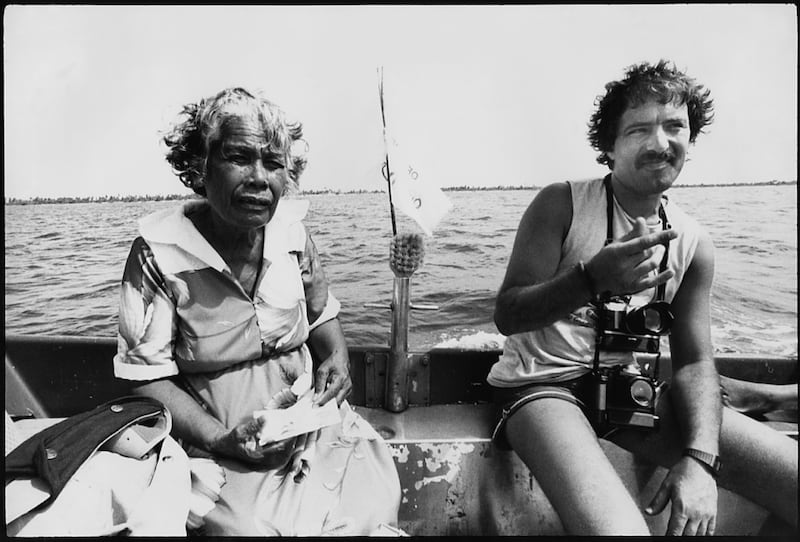
Tui Warmenhoven (Ngāti Porou), the chair of the Greenpeace Aotearoa board, said it was a day to remember for the harm caused by the French state against the people of Mā’ohi Nui.
Warmenhoven worked for 20 years in iwi research and is a grassroots, Ruatoria-based community leader who works to integrate mātauranga Māori with science to address climate change in Te Tai Rāwhiti.
She encouraged Māori to stand united with Greenpeace.
“Ko te mea nui ki a mātou, a Greenpeace Aotearoa, ko te whawhai i ngā mahi tūkino a rātou, te kāwanatanga, ngā rangatōpū, me ngā tāngata whai rawa, e patu ana i a mātou, te iwi Māori, ngā iwi o te ao, me ō mātou mātua, a Ranginui rāua ko Papatūānuku,” e ai ki a Warmenhoven.
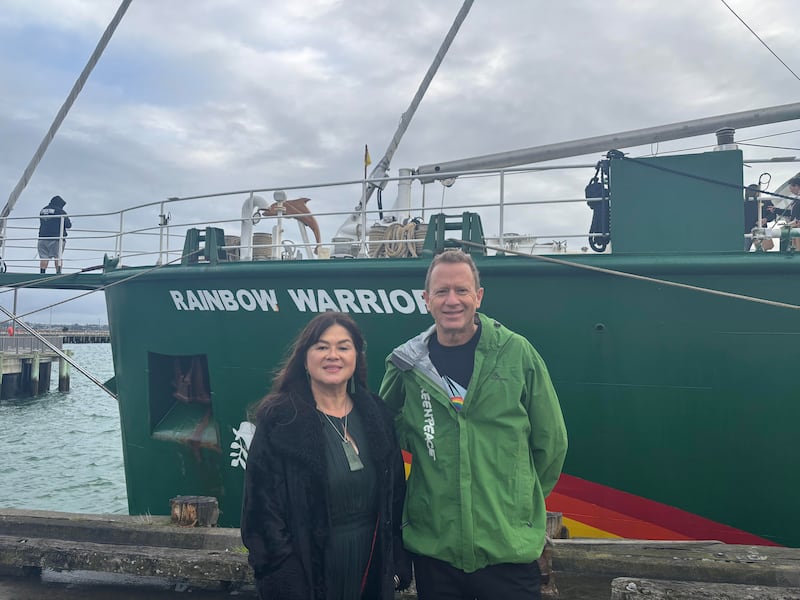
A defining moment in Aotearoa’s nuclear-free stand
“The bombing of the Rainbow Warrior was a defining moment for Greenpeace in its willingness to fight for a nuclear-free world,” said Dr Russel Norman, the executive director of Greenpeace Aotearoa.
He noted it was also a defining moment for Aotearoa in the country’s stand against the United States and France, who conducted nuclear tests in the region.
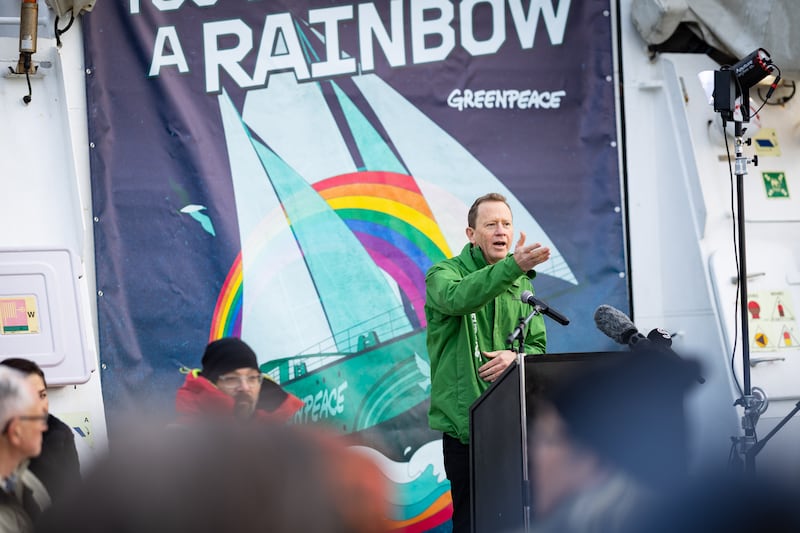
In 1987, the New Zealand Nuclear Free Zone, Disarmament, and Arms Control Act officially declared the country a nuclear-free zone.
This move angered the United States, especially due to the ban on nuclear-powered or nuclear-armed ships entering New Zealand ports.
Because the US followed a policy of neither confirming nor denying the presence of nuclear weapons, it saw the ban as breaching the ANZUS Treaty and suspended its security commitments to New Zealand.
The Rainbow Warrior’s final voyage before it was bombed was Operation Exodus, during which the crew helped relocate more than 320 residents of Rongelap Atoll in the Marshall Islands, who had been exposed to radiation from US nuclear testing between 1946 and 1958.
The legacy of Operation Exodus
Between 1946 and 1958, the United States carried out 67 nuclear tests in the Marshall Islands.
For decades, it denied the long-term health impacts, even as cancer rates rose and children were born with severe deformities.
Despite repeated pleas from the people of Rongelap to be evacuated, the US government failed to act until Greenpeace stepped in to help.
“The United States government effectively used them as guinea pigs for nuclear testing and radiation to see what would happen to people, which is obviously outrageous and disgusting,” Dr Norman said.
He said it was important not to see Pacific peoples as victims, as they were powerful campaigners who played a leading role in ending nuclear testing in the region.
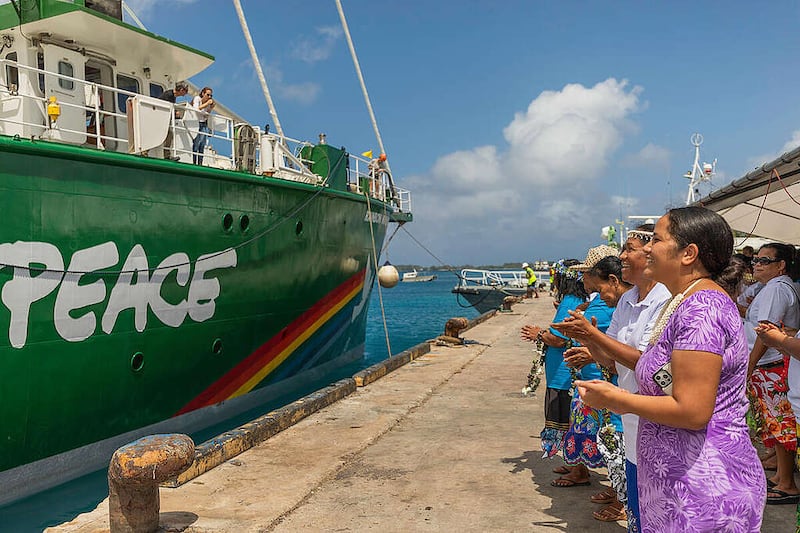
Between March and April this year, Rainbow Warrior III returned to the Marshall Islands to conduct independent research into the radiation levels across the islands to see whether it’s safe for the people of Rongelap to return.
What advice do you give to this generation about nuclear issues?
“Kia kotahi ai koutou ki te whai i ngā mahi uaua i mua i a mātou ki te whawhai i a rātou mā, e mahi tūkino ana ki tō mātou ao, ki tō mātou kōkā a Papatūānuku, ki tō mātou taiao,” hei tā Tui Warmenhoven.
A reminder to stay united in the difficult world ahead in the fight against threats to the environment.
Warmenhoven also encouraged Māori to support Greenpeace Aotearoa.
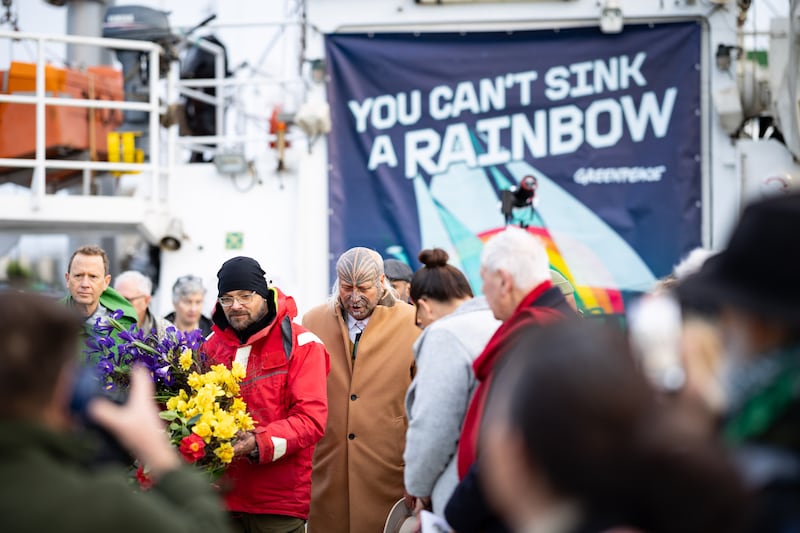
Dr Norman believed the younger generations should be inspired to activism by the bravery of those from the Pacific and Greenpeace who campaigned for a nuclear-free world 40 years ago.
“They were willing to take very significant risks, they sailed their boats into the nuclear test zone to stop those nuclear tests, they were arrested by the French, beaten up by French commandos,” he said.
Republished from Te Ao Māori News with permission.
This post was originally published on Asia Pacific Report.
By Aui’a Vaimaila Leatinu’u of PMN News
I didn’t know much about the surrounding context of the infamous Rainbow Warrior bombing 40 years ago on Thursday. All I knew was that we, as a country, have not forgotten.
I was born in 1996, and although I didn’t know much about the vessel’s bombing, which galvanised anti-nuclear sentiment across Aotearoa further, the basics were common knowledge growing up.
So, when I got the opportunity to read the Eyes of Fire: The Last Voyage and Legacy of the Rainbow Warrior (40th Anniversary edition) by veteran journalist David Robie, who was on board the ship during its mission to the Marshall Islands, I dove in.
On 10 July 1985, French secret agents destroyed the Rainbow Warrior at Marsden Wharf in Auckland, killing Portuguese-born Greenpeace photographer Fernando Pereira and sparking global outrage.
The Rainbow Warrior protested nuclear weapons testing in the Pacific, specifically targeting French atmospheric and underground nuclear tests at Moruroa and Fangataufa atolls.
Their efforts drew international attention to the environmental devastation and human suffering caused by decades of radioactive fallout.
There’s plenty to learn from this book in terms of the facts, but what I took away from it most is its continued relevance since its original publication in 1986.
The opening prologue is former New Zealand Prime Minister Helen Clark’s reflection on the Warrior’s bombing, Pereira’s death and the current socio-political climate of today in relation to back then.
Clark makes remarks on AUKUS, nuclear weapons and geopolitical pressures, describing it all as “storm clouds gathering again”.

Nuclear fallout
It has been a tumultuous period for the Pacific region in the political realm, between being at the mercy of a tug-of-war between global superpowers and the impending finality of climate change to the livelihoods of many.
With EOF’s 40th Anniversary edition, it is yet another documentation of these turbulent times for the Pacific, which have never really stopped since colonial powers first made contact.
Between 1946 and 1958, the United States conducted 67 atmospheric and underwater tests in the Marshall Islands. Then, in 1966, the French launched 46 atmospheric tests between 1966 and 1974, followed by 147 underground bombs from 1975 to 1996 after widespread international protest and scrutiny.
Specifically, the US 1954 Castle Bravo nuclear test, the largest atmospheric hydrogen bomb test, resulted in the fallout’s ash coating Rongelap Atoll. Though the US evacuated residents days later, they returned them in 1957, leaving them to suffer from health effects like miscarriages, cancer, and birth deformities.
Eventually, the Rainbow Warrior helped evacuate the Rongelap people in 1985 over several trips, where the locals packed down their homes and brought them onboard.
Throughout history to today, there’s a theme of constant disregard and dehumanisation of my people by the West.

When does it stop?
A decade prior to the Rongelap evacuation, the infamous Dawn Raids occurred, where it wasn’t until 1986 that a Race Relations investigation found Pacific people comprised roughly a third of overstayers yet represented 86 per cent of all prosecutions.
The 506-day Bastion Point protest also occurred between 1977 and 1978, where Ngāti Whātua, led by Joe Hawke, pushed back against a proposed Crown sale of that land.
In the end, around 500 NZ police and army forcefully evicted the peaceful protestors.
So, while this was all happening, the Pacific, specifically the Marshall Islands and French Polynesia region, were reeling from the decades of nuclear testing and consequential sickness, pain and death.
Today, the Pacific is stuck between geopolitical egos, the fear of being used as a resource stepping stone, internal struggles, economic destabilisation and pleas for climate change to be made a priority not to save sinking islands but the world.
Amid this “political football”, it constantly feels like Pacific and Māori end up being the ball.
Robie’s book tells heartfelt moments with its facts, which helps connect to its story at a deeper level beyond sharing genealogy with the people involved.
Voices within it don’t hold back their urgency or outrage towards what happened, especially how that past negligence by bodies of power continues today.
When I read books like EOF 40th, whether it’s about my tangata Māori or Tagata Moana, I often close them and wonder: When do we get a break? When does it stop?
I wish I had an answer, but I don’t. At least we will always have answers on what happened to the Rainbow Warrior and why.
No matter what, it is indisputable that an informed generation will navigate the future better than their predecessors, and with EOF 40th, they’ll be well-equipped.
Republished from PMN News with permission.
This post was originally published on Asia Pacific Report.
TVNZ 1News
The Greenpeace flagship Rainbow Warrior has sailed into Auckland to mark the 40th anniversary of the bombing of the original Rainbow Warrior in 1985.
Greenpeace’s vessel, which had been protesting nuclear testing in the Pacific, sank after French government agents planted explosives on its hull, killing Portuguese-Dutch photographer Fernando Pereira.
Today, 40 years on from the events on July 10 1985, a dawn ceremony was held in Auckland.
Author Margaret Mills was a cook on board the ship at the time, and has written about her experience in a book entitled Anecdotage.
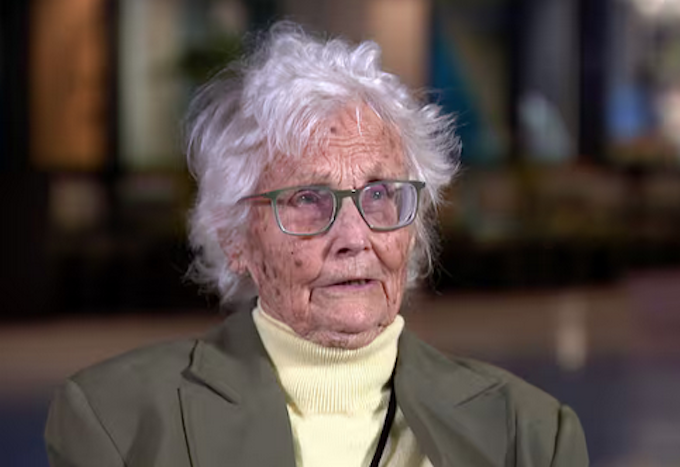
The 95-year-old told TVNZ Breakfast the experience on board “changed her life”.
“I was sound asleep, and I heard this sort of bang and turned the light on, but it wouldn’t go on.
She said when she left her cabin, a crew member told her “we’ve been bombed”.
‘I laughed at him’
“I laughed at him, I said ‘we don’t get bombs in New Zealand, that’s ridiculous’.”
She said they were taken to the police station after a “big boom when the second bomb came through”.
“I realised immediately, I was part of a historical event,” she said.
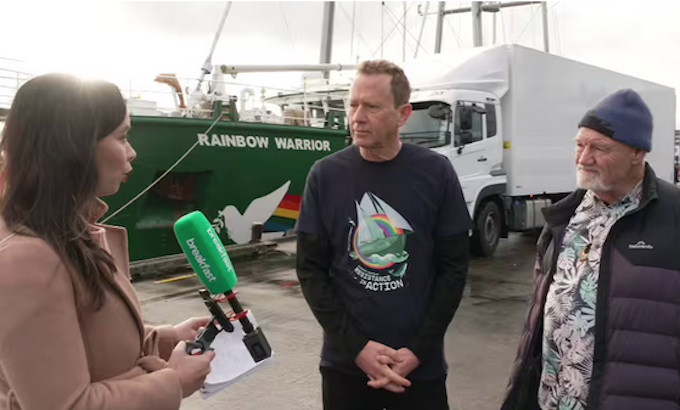
Journalist David Robie. who travelled on the Rainbow Warrior and wrote the book Eyes of Fire: The Last Voyage and Legacy of the Rainbow Warrior published today, told Breakfast it was a “really shocking, shocking night”.
“We were so overwhelmed by the grief and absolute shock of what had happened. But for me, there was no doubt it was France behind this.”
“But we were absolutely flabbergasted that a country could do this.”
He said it was a “very emotional moment” and was hard to believe it had been 40 years since that time.
‘Momentous occasion’
“It stands out in my life as being the most momentous occasion as a journalist covering that whole event.”
Executive director of Greenpeace Aotearoa Russel Norman said the legacy of the ship was about “people who really stood up for something important”.
“I mean, ending nuclear testing in the Pacific, imagine if they were still exploding bombs in the Pacific. We would have to live with that.
“And those people back then they stood up and beat the French government to end nuclear testing.
“It’s pretty inspirational.”
He said the group were still campaigning on some key environmental issues today.
This post was originally published on Asia Pacific Report.
Anduril Industries is a major beneficiary of the One Big Beautiful Bill Act, which includes a section that essentially grants the weapons firm a monopoly on new surveillance towers for U.S. Customs and Border Protection across the southern and northern borders.
The legislation, signed into law by President Donald Trump on July 4, provides significant spending increases to military and law enforcement projects, including over $6 billion for various border security technologies. Among these initiatives is expanding the ever-widening “virtual wall” of sensor-laden surveillance towers along the U.S.-Mexico border, where computers increasingly carry out the work of detecting and apprehending migrants.
Anduril, today a full-fledged military contractor, got its start selling software-augmented surveillance towers to CBP. Anduril has pitched its Sentry Tower line on the strength of its “autonomous” capabilities, which use machine learning software to perpetually scan the horizon for possible objects of interest — i.e. people attempting to cross the border — rather than requiring a human to monitor sensor feeds. Thanks to bipartisan support for the vision of a border locked down by computerized eyes, Anduril has become a dominant player in border surveillance, edging out incumbents like Elbit and General Dynamics.
Now, that position looks to be enshrined in law: A provision buried in the new mega-legislation stipulates that none of the $6 billion border tech payday can be spent on border towers unless they’ve been “tested and accepted by U.S. Customs and Border Protection to deliver autonomous capabilities.”
The bill defines “autonomous” as “a system designed to apply artificial intelligence, machine learning, computer vision, or other algorithms to accurately detect, identify, classify, and track items of interest in real time such that the system can make operational adjustments without the active engagement of personnel or continuous human command or control.”
Anduril is now the country’s only approved border tower vendor.
That reads like a description of Anduril’s product — because it might as well be. A CBP spokesperson confirmed to The Intercept that under the new law, Anduril is now the country’s only approved border tower vendor. Although CBP’s plans for border surveillance tend to be in flux, Homeland Security presentation documents have cited the need for hundreds of new towers in the near future, money that for the time being will only be available to Anduril.
Anduril did not respond to a request for comment.
In a statement to The Intercept, Dave Maass, investigations director at the Electronic Frontier Foundation and a longtime observer of border surveillance technologies, raised concerns about the apparent codification of militarized AI at the border. “I was cynically expecting Trump’s bill to quadruple-down on wasteful surveillance technology at the border, but I was not expecting language that appears to grant an exclusive license to Anduril to install AI-powered towers,” he said. “For 25 years, surveillance towers have enriched influential contractors while delivering little security, and it appears this pattern isn’t going to change anytime soon. Will this mean more towers in public parks and AI monitoring the everyday affairs of border neighborhoods? Most likely. Taxpayers will continue footing the bill while border communities will pay an additional price with their privacy and human rights.”
“Taxpayers will continue footing the bill while border communities will pay an additional price with their privacy and human rights.”
The law’s stipulation is not only a major boon to Anduril, but a blow to its competitors, now essentially locked out of a lucrative and burgeoning market until they can gain the same certification from CBP. In April, The Intercept reported on a project to add machine learning surveillance capabilities to older towers manufactured by the Israeli military contractor Elbit, and General Dynamics has spent years implementing an upgraded version of its Remote Video Surveillance System towers. The fate of these companies’ border business is now unclear.
Elbit did not respond to a request for comment. General Dynamics spokesperson Jay Srinivasan did not respond directly when asked about Anduril’s border exclusivity deal, stating, “We can’t speculate on the government’s acquisition strategy and the different contracts it intends to use to exercise the funding,” and pointed to the company’s existing surveillance tower contracts.
Towers like Anduril’s Sentry have proven controversial, hailed by advocates in Silicon Valley and Capitol Hill as a cheaper and more humane way of stopping illegal immigration than building a physical wall, but derided by critics as both ineffective and invasive. Although border towers are frequently marketed with imagery of a lone edifice in a barren desert, CBP has erected surveillance towers, which claim to offer detailed, 24/7 visibility for miles, in populated residential areas. In 2024, the Government Accountability Office reported CBP’s surveillance tower program failed to address all six of the main privacy protections that were supposed to be in place, including a rule that “DHS should collect only PII [Personally Identifiable Information] that is directly relevant and necessary to accomplish the specified purpose(s).”
The new Trump spending package emphasizes the development and purchase of additional autonomous and unmanned military hardware that could prove favorable for Anduril, which has developed a suite of military products that run on machine learning-centric software. One section, for instance, sets aside $1.3 billion for “for expansion of unmanned underwater vehicle production,” an initiative that could dovetail with Anduril’s announcement last year that it would open a 100,000–150,000 square foot facility in Rhode Island dedicated to building autonomous underwater vehicles. Another sets aside $200 million for “the development, procurement, and integration of mass-producible autonomous underwater munitions,” which could describe Anduril’s Copperhead line of self-driving torpedoes, announced in April.
The bill also earmarks billions for suicide attack drones and counter-drone weaponry, technologies also sold by Anduril. Anduril is by no means the only contractor who can provide this weaponry, but it already has billions of dollars worth of contracts with the Pentagon for similar products, and enjoys a particularly friendly relationship with the Trump administration.
Trae Stephens, Anduril’s co-founder and executive chairman, served on Trump’s transition team in 2016 and was reportedly floated for a senior Pentagon position late last year. Michael Obadal, Trump’s nominee for Under Secretary of the Army, worked at Anduril until June, according to his Linkedin, and has come under fire for his refusal to divest his Anduril stock.
Anduril founder Palmer Luckey is also longtime Trump supporter, and has hosted multiple fundraisers for his presidential campaigns.
Following Trump’s reelection last fall, Luckey told CNBC he was sanguine about his company’s fortunes in the new administration. “We did well under Trump, and we did better under Biden,” he said of Anduril. “I think we will do even better now.”
The post Trump’s Big Beautiful Gift to Anduril appeared first on The Intercept.
This post was originally published on The Intercept.
By Rabbi Neil Janes
Who is the ‘regular’ Jew – your neighbour, friend, colleague and why are they feeling so anxious this week?
In this piece, you’ll meet a regular Jewish family and hear how they experience the world and why recent events are such a worry for them – and what we can all do about it.
I say to you as their rabbi, there can be no making peace in the world if it’s at the cost of Jews…and their history and deeply held core aspects of their identity.
Until that is accepted, there is a clear label for opposition to such a stance: anti-Jewish racism.
Allow me to introduce you to the Smith family. They’re an imaginary family from middle England and they are Jewish.
They’re almost definitely members of a Progressive synagogue and certainly strongly identify with their Jewish identity.
They’ve lived in Britain all their lives and worked hard. They’ve raised their children, sent them to university, paid taxes. And when they go to synagogue, they want their synagogue to be liberal, tolerant, inclusive.
They love the fact that their rabbi is a woman and their community has a Pride Shabbat.
And when it comes to Israel and the Palestinians?
They’ve been lifelong donors to peace charities, organisations working in the field and whenever they visit Israel, they ensure that they visit Arab-Israeli coexistence projects and hear from Palestinians living in the West Bank.
They are as close as you can get to what you probably imagine is the good Jew…(though for some, they are not ‘good enough’ Jews because they haven’t disavowed Zionism and believe in Israel’s right to exist).
If you saw them walking down the street you probably wouldn’t even know they were Jewish… Except for the fact that they probably invited you to their children’s weddings, bat mitzvahs and maybe even a home Chanukah lighting.

The Smiths ended up in the UK because half of the family were refugees from Nazi Europe.
Two-thirds of this side of the family was murdered and a third survived. Some came to the UK. Some had sought refuge in what was then British Mandate Palestine – there were no other places in the world that they could go.
The other side of their family were refugees from Egypt. Around the time of the Suez crisis the family had to leave Alexandria. A few of the family came to the UK.
The rest of the family, because they couldn’t get visas anywhere else, went to Israel. Of course, there were also the cousins who were already in Israel along with the dispersed family across practically every corner of the globe.
For centuries, no matter where their families were, they prayed in the direction of the historic homeland of the Jewish people.

Why am I spending so long introducing the Smiths to you?
Because this is the Jewish Household which makes up the majority of the approximately 250,000 Jews that live in the UK ( at least those that live outside of the main Jewish population centres).
They’re not famous, they’re not VIP’s, they’re not politicians, they don’t have podcasts or public social media profiles, they don’t work in the Jewish community, they’re not on the streets, they don’t fly flags.
They donate to Jewish charities. And they will be buried in a Jewish cemetery.
And there’s every chance that they live in a part of the UK where the Jewish community numbers just 0.3% of the population.
The closest they get to identity politics is that they wear a small Star of David necklace and have placed their mezuzah on the door outside of their house.
Although lately they’ve considered moving it inside.
And they regularly turn up to interfaith activities and help coordinate the Holocaust Memorial Day service in their local council chambers.
Lately, though, the Smiths have become more and more anxious.
There’s regular graffiti in the villages and towns. Sometimes it’s just swastikas. But it’s also included calls for death to Jews or to ‘F*** Israel’.
They’ve heard from their friends that their grandchildren are being targeted in school in the playground and “I love Hamas” has been graffitied on to the desks.
But that’s not what’s making them anxious lately. That’s just since 7th October 2023.
Lately, the tone of political discourse has become coarser and more violent.
The Smiths admit they’re probably online too much and seeing the viciousness of debate, sometimes they go to bed feeling scared. And it’s not just in person and online discourse.
There have been recent murders of Jews and Israelis in other parts of the world and it always feels close to home. Violent acts of vandalism and abuse on the streets.
The campaigning is apparently to help the Palestinians and draw attention to the plight of Gazans. But for them it appears to be at the cost of their security as citizens of the UK.
They don’t feel that they can trust the national broadcaster, the BBC, because whilst the excuse of broadcasting violent chants for death seems to be ‘it was a mistake’, it feels too contrived.
And they saw the hordes of concert goers, at a festival, not only supporting the chant for death of Israelis, but also calling for a ‘Free Palestine’ which is deniable but seems to be clearly a shorthand for ‘Free from the river to the sea’ and destruction of Israel.
It looked to them like something from a far-right rally or the 1930s.
They know what this means. And they know what it means because they’re no longer allowed to discuss, display or give voice to their support for Zionism.
They know what it means because their nephews and nieces have all served in the IDF and now apparently they deserve to die.
Cousins’ homes have been destroyed from the missile barrages from the Islamic Republic of Iran and this has been celebrated by throngs of people.
They know what it means because they go to their synagogue and hear prayers for peace, for Palestinians and Israelis, and they see no equivalent anywhere else – just for freeing Palestine and certainly barely a call for a release of hostages.
Members of their community have got relatives and friends who have been murdered or were taken hostage.

Where they are praying for peace and are desperate to change the humanitarian situation in Gaza and end the horror of innocent deaths, it feels like everywhere else is calling for destruction.
They know what it means because in living memory their families were made unwelcome in the countries in which they found themselves.
And the small number of Jews that ended up in Britain have always thought that this would be their forever home. Even though they were separated from other family members whose forever home is the State of Israel.
They know what it means because they see online that Israeli (Jewish) influence is constantly the centre of conspiracy theories of global power.
They know what it means because their local MP refuses to speak out on the question of Jewish and Israeli lives in as public and regular way as they regularly speak out about Gaza and Palestinians.
They’re told it’s because of the size of their mailbox.
They know what it means because the synagogue activities require a password and a security guard and no publicity.
They know what it means because the local peace and justice group which obsesses about either the rights of Palestinians or the environment has nothing to say when chants for death are heard on their television screens.
And there is no outrage from the councillors who are never shy about how they want the world to live in peace.
They know what it means because it’s no longer good enough for them to have been a good Jew. They now must be either a closet Jew or change their opinions.
They know what it means because their grandchild’s university can run a course about ‘Religion and War’ in 2024 with several lectures about Islam and Gaza but without any mention of Jews, Hamas and anti-Judaism.
And the same university had to cut short a meeting because of fears for safety of Jews in the room due to protestors.
They know what it means because it seems no matter how much their rabbi is involved in local interfaith social cohesion projects their local MP and council seems to be disinterested in tackling deep rooted anti-Judaism.
And they know what it means because apparently the cost of Jewish community security in this country and their concerns about the calls for violence which were broadcast on the national broadcaster are dismissed as irrelevant in the face of the plight of Palestinians in Gaza.
And I say to you as their rabbi, there can be no making peace in the world if it’s at the cost of Jews, like the Smith family, and their history and deeply held core aspects of their identity.
Until that is accepted, there is a clear label for opposition to such a stance: anti-Jewish racism.
My rabbinate changed in 2023.
I realised that I had to work harder and in a more focused way on the need for social cohesion here in the UK with the Jewish voice actively engaged in the wider conversation. Even when I hear and see problematic material sometimes shared by other faith community leaders.
My task was to build bridges with sincere and serious friends across all faiths and none in the hope that we could jointly diminish the radicalised voices and amplify the voice of hope.
I needed to pray harder for peace which seemed beyond all our reaches and pledged my support for people involved directly in the hard work of building a better more peaceful world for Israelis and Palestinians and all life on this planet.
And I needed to redouble my efforts to protect my community and ensure that they could continue to celebrate every aspect of their identity, including a connection to the land and State of Israel, with every political hue of member who comes to our services. Including when that means calling out uncomfortable truths on their behalf.

But…let me be clear: if there can only be peace without Jews and their ideas, there is a name for that. Anti-Jewish Racism.
The Smiths know it. I know it. And it’s about time the rest of the world said they knew it and called it out too.
But sadly the Smiths don’t have much confidence in that happening and sadly, neither do I.
This blog was written by Rabbi Neil Janes and was first published on 01/07/2025.

This post was originally published on Voice of Salam.
Shai Davidai is leaving Columbia University.
Per an email sent to Columbia Business School faculty on Wednesday morning from Dean Costis Maglaras and obtained by The Intercept, the vocal pro-Israel business school assistant professor made the decision to leave the school.
Davidai soon followed the internal announcement with a social media post declaring that Columbia’s Office of Institutional Equity had cleared him of allegations filed against him in February of last year. He was temporarily suspended last year after Columbia said he “repeatedly harassed and intimidated University employees in violation of University policy.”
“BOOM,” Davidai wrote, alongside a screenshot of a note on Columbia letterhead from the vice provost for the Office of Institutional Equity. Davidai and a Columbia University spokesperson did not immediately respond to a request for comment.
Davidai, who joined the business school in 2019, received viral attention for his pro-Israel tirades and self-filmed videos of his confrontations with pro-Palestine protesters. Several students, including Mahmoud Khalil and Mohsen Mahdawi, have also alleged that Davidai targeted them and called for them to be deported in the lead-up to their arrests by Immigration and Customs Enforcement.
Davidai was also a member of a prominent WhatsApp group of Columbia alumni, parents, and professors that strategized about how to deport pro-Palestine students, The Intercept reported. He has noted that he does not have tenure at the school.
The post Pro-Israel Professor Shai Davidai Is Leaving Columbia appeared first on The Intercept.
This post was originally published on The Intercept.